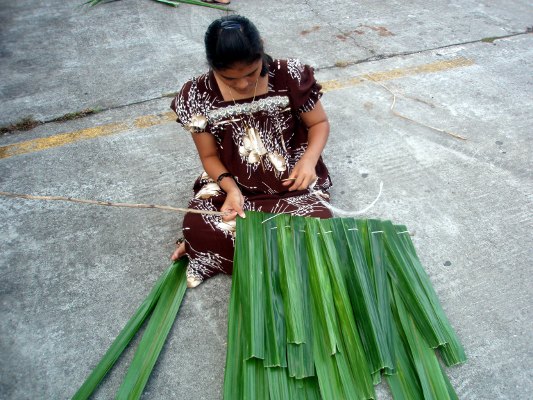

Edition 4.3
Dana Lee Ling
Table of Contents
Micronesian Ethnobotany: A Course Companion
A compilation of handouts used in SC/SS 115 Ethnobotany
Dana Lee Ling
College of Micronesia–FSM
Pohnpei, Federated States of Micronesia
Material cited as being from other sources retains the rights reserved by that source.
Licensing of original material: Micronesian Ethnobotany A Course Companion by Dana Lee Ling is licensed under a Creative Commons Attribution 4.0 International License. To view a copy of this license, visit http://creativecommons.org/licenses/by/4.0/.
GN476.73
Federated States of Micronesia 2020
Credits
Using a substance eventually leads to depletion of that substance. Employing a tool abrades and wears down the tool until the tool must be replaced. Running equipment often eventually leads to the equipment falling into disrepair. Knowledge is different. Only the lack of use of knowledge leads to its depletion. Employing knowledge builds up the strength of the knowledge. Using knowledge often keeps the knowledge from falling into a state of disrepair. Knowledge is lost only when knowledge is not used and not shared. Knowledge is a gift. A gift that if not used, is lost. A gift that if used, is kept strong and bright. There is no way to repay a gift of knowledge. There is nothing one can share back to the giver to thank them for a gift that keeps on giving.
This course companion is the direct result of the work of Dr. Michael Balick of the New York Botanic Garden. Some of the notes are based on lectures that were originally built from material in Plants, People, and Culture: The Science of Ethnobotany, Michael J. Balick and Paul Alan Cox. The bulk of the Micronesian material derives from Micronesians sharing their knowledge, both students in the class and members of the community. Debts of gratitude are also owed to Francisca Sohl, Totoa Fetalai-Currie, Bill Raynor, Roberta Lee, David Lorence, Felisihna Spencer Samuel, Robert Andreas, and Tadao Waguk, for their contributions to information contained in this course companion.
Thanks are due also to the staff, faculty, and administration of the College of Micronesia-FSM for their steadfast support for the course and related projects.
There are many others who have contributed to the knowledge in this course companion. The list is far too long to include in this text. Whatever knowledge may be compiled in this companion is my all too meager means of thanking those who have made this companion possible.
This course companion is designed to accompany SC/SS 115 Ethnobotany at the College of Micronesia-FSM, Palikir site. The companion derives from a compilation of course handouts. The flora lists pertain to gardens and collections on the island of Pohnpei in the Federated States of Micronesia.
The single page structure of this text is intentional and is intended to permit students with mobile devices the ability to load the page in a single browser tab and then carry the text around on the device even in areas with an absence of connectivity. For many students connectivity is limited to campus. Away from campus the students have no connectivity. The structure also permits printing the text as a single page numbered print job.
All errors are solely those of the principal author.
Ethnobotany is the science of the study of the plants people use and the ways in which those plants are used. Ethnobotanists work with people and their plants. Doing ethnobotany requires knowing both the scientific botanical classification and identification systems as well as knowing how to perform ethnological and ethnographic work among a people who use plants.
Humans have certain physical and material needs that must be fulfilled in order to survive and to thrive. First and most fundamentally one seeks food. Then one seeks protection and shelter. When sick, one seeks medicine. When bored, one seeks entertainment. There are times when one seeks beauty. Plants have provided all of these things in Micronesia. Plants feed us, clothe us, house us, heal us, entertain us, and bring beauty into our lives. Ethnobotanists work with the people who know how to use plants in the above ways to document cultural uses of plants.
Ethnobotany is an integrative science. The ethnobotanist uses knowledge from disciplines including botany, ethnology, anthropology, ecology, nutrition, medicine, linguistics, economics, biochemistry, and agriculture. The field has spawned a number of related fields and subfields such as ethnobiology, ecoethnobotany, socioethnobotany, and ethnomycology.
While one original aim of ethnobotany was to find useful food plants that might benefit all peoples, modern ethnobotany also seeks to help those who provide the information conserve their plant knowledge and thus a part of their way of life. The work of a modern ethnobotanist must enhance the lives of those who share their knowledge with the ethnobotanist, as well as protecting the botanical resources of the area.
This text weaves together the botanical science of plant diversity and the uses of plants in Micronesia. These topics are interleaved in the following text, with chapters weaving between botanic diversity and culture uses of plants.
Plant diversity is the identification of plants using scientific names for the plants. These sections also look at plant reproduction and development as these are what organize plants in science.
Plants are identified by a combination of two words in the Latin language. These two word combinations are called a binomial. "Bi" means two and "nomial" means "name." The coconut tree is called Cocos nucifera. The first name is the genus and the second name is the species. A genus can have many plants, each has their own species name. Black pepper is Piper nigrum, Betel leaf is Piper betel, the Pohnpei pepper plant (konok) is Piper ponapense, and sakau(kava) is Piper methysticum. These are all pepper plants, all in the genus Piper.
The cultural uses of plants will examine four areas of Micronesian plant usage. Plants for healing, plants for food, plants used in material culture, and plants used ceremonially.
The topics covered are listed below. Note the sequence is indicated by the chapter numbers, the course interweaves the natural science of botany and the social science of how people interact with and use their plants.
Natural Science of Botany
Most primitive, least evolved:
1. cyanobacteria
[algae]
More complex, more evolved
2. Primitive plants
Mosses: spore capsules, spores, sperm, eggs
Seedless Vascular Plants
psilotum: cones, spores, sperm, eggs
lycopodium: cones, spores, sperm, eggs
ferns: sori, spores, sperm, eggs
4. Seeded non-flowering plants (cone bearing plants):
gymnosperms: cones, pollen, naked seeds
Most complex, evolved
Seeded flowering plants angiosperms:
6. vegetative morphology: leaf shape
8. floral morphology: flower shape
9. fruit with seeds
Social science of how people interact with and use plants
3. Healing plants
Plants that heal us
5. Food plants
Plants that feed us
7. Material culture plants
Plants that provide shelter, transportation, clothing, and that
decorate our bodies, homes, and gardens
10. Sacred plants
Plants that entertain, inspirit, and enrapture us
The botanic science side of the text begins with a non-plant, cyanobacteria. Cyanobacteria has been on earth for billions of years. As the name suggests, cyanobacteria is a bacteria. Cyan is a blue-green color. Cyanobacteria used to be called "blue-green algae." Now it is no longer included with algae, which are more complex.
There are many different types of cyanobacteria. One of the more noticeable types in Micronesia is Nostoc commune. Cyanobacteria can be found on open, rocky, gravelly ground in sunny places. Cyanobacteria looks like blobs or balls of green jelly when wet. When the sun comes out, the cyanobacteria dries up, shrivels, and turns black.
Later the text will examine increasingly complex forms of plant life. Plants evolved over hundreds of millions of years. The evolutionary sequence is depicted in illustration one, from simplest and oldest on the top and right, to most complex and most recently evolved at the bottom left.
Diagram inspired by one done by Jane Langdale
Cyanobacteria is a bacteria that can photosynthesize. Photosynthesis is the production of food from light, usually a form of sugar. Think of sugar cane, Saccharum officinarum, the stem is filled with sweet sugar. This is produced in the leaves of the plant via photosynthesis. Cyanobacteria also produces sugars, but other contents of cyanobacteria make the plant inedible for humans.
Cyanobacteria has one other capability that is very important to life on earth. Nitrogen is an element that is very important to all living things. Nitrogen is needed in the energy burning systems of all living things. Moving muscles requires compounds that have nitrogen.
Fortunately, 80% of the air consists of nitrogen. Unfortunately, no living thing can use the nitrogen in the air. The nitrogen in the air is in the form of two nitrogen atoms bonded to each other, N2. In this form nitrogen is inert – that means chemically inactive.
Living things need nitrogen in other forms. Only cyanobacteria can break the N2 bond and provide all other living things with nitrogen in the forms the living things can use.
Humans do not eat cyanobacteria, so how do humans get their nitrogen? There are plants that are able to get nitrogen compounds from cyanobacteria. Then humans eat those plants, or humans eat animals that eat those plants. When humans eat, they ingest the nitrogen in forms the human body can use.
Cyanobacteria is known across Micronesia and there are names for it on many islands. No one claims that cyanobacteria has any use. The genus for the green balls of jelly that turn black under the sun is Nostoc commune. There are many species of Nostoc, and only a chemical analysis can sort out different species. When the species names is not known, then the abbreviation spp. is used.
Mosses are the most primitive plants. Mosses are very simple plants. Mosses do not have true stems, leaves, or roots. Most critically, mosses lack a network of tubes to transport water through the plant. This network of tubes is referred to as a vascular system. Mosses cannot move water from the ground up to distant leaves. Mosses do not have roots with which to drill down to underground water. As a result mosses are small and prefer wet places. Mosses are small, green, wet, and cute. Mosses can absorb water directly, hence the rocks around misty waterfalls are a favorite home for mosses.
Mosses do not produce flowers or seeds. Mosses consist of plants that produce eggs and swimming sperm. The sperm also needs water to swim from the sperm producing moss to an egg producing moss. The sperm and egg join and the result is NOT a baby moss. The result is a tall, brown stem-like structure with a pod full of spores on the end. When the pod dries out it shrinks, raising the air pressure inside. Eventually a cap on the pod blows off and the spores are ejected.
If a spore lands on a wet, fertile location, then the spore grows into a new moss plant.
Note that while some moss plants make sperm and some make eggs, it is not correct to think of one as male and the other as female. The plants do not move around, they cannot "have sex", and the plants look the same. Despite this, some botanists and many instructors tend to fall back on gender language, referring to "male plants" and "female plants" to distinguish between sperm and egg producers.
The story of the evolution of plants is that of plants finding ways to overcome limitations. Mosses cannot store water, cannot move water through their tissues, and need water to reproduce. These are all limitations in the competitive world of plants. The competition is for space in which to grown and, most importantly, sunlight. Sunlight is the energy source for food production by plants. Sunlight powers photosynthesis. Sunlight is food. A lack of sunlight is death. For a plant the battle is for sunlight or death.
The sun is up above the earth during the day, so the tallest plant gets the sunlight. Tall wins. Mosses cannot move water, so they cannot be tall. This is a huge limitation.
Seedless vascular plants evolved from mosses around 380 to 400 million years ago. The new development was that of a system of tubes to carry both water and sugars around inside the plant. These networks of tubes are inside of stems and leaves, and extend down into the root-like structures. These tubes are called the "vascular" system of the plant. These plants still use swimming sperm, eggs, and spores in their reproductive cycles, hence their name: seedless vascular plants (SVP).
There are two basic groups present in Micronesia that scientists call phyla: Lycophyta and Monilophyta. The Lycophytes include lycopodium and selaginella. The Monilophytes include ferns and a psilotum.
Across Micronesia mosses and seedless vascular plants have local names and important uses. Some of the more common primitive plants seen across Micronesia are listed below. The list is roughly in the order that the ferns are encountered on a hike at the national campus of the College of Micronesia-FSM on Pohnpei.
One hypothesis as to why plants produce medically active chemical compounds centers on the fact that "plants cannot run." If you are an animal you can survive by running or fighting back. Plants cannot run. They must defend themselves against being eaten by other means. Powerful chemical compounds that affect animals are thought to be one way in which plants defend themselves. If an animal is poisoned or disabled by a chemical compound in a plant, then maybe the animal will be unable to finish eating that plant. Those same chemical compounds may in more limited quantities be medicinal. Flowering plants (angiosperms) in particular have developed diverse and unique molecular defenses against herbivores – animals that eat plants (Sumner, 2008).
Another hypothesis notes that plants are attacked by viruses, bacteria, and fungi. Plants have to defend themselves against these attackers, but lack a complex immune system such as animals have. Plants have developed a chemical arsenal to kill off attacking viruses, bacteria, and fungi. Some of those same compounds work for animals including humans in fighting off the same microbes.
A third theory is applied to some plants. Some plants appear to attract animals intentionally. The plant offers up a relatively expendable part of the plant, in exchange the animals behavior patterns are beneficial to the plant. There is a grass in Africa preferred by elephants. The elephants eat the blades, but never damage the underground portions of the grass. The elephants trample other forms of vegetation that would eventually shade the grass to death. The elephants even intentionally uproot and kill inedible bushes that would shade out their favorite grass. Who is benefiting here? Both the grass and the elephant. The elephant gets fed, the grass gets rid of its competition on the savanna plains of Africa (Attenborough, 1995). In this theory plants which produced chemical compounds that benefit their benefactor - the animal that is protecting the plant - would be more likely to survive.
Indigenous peoples are those descendants of the original inhabitants of a location. Non-indigenous people are those who are not ancient inhabitants of a place. Usually only the indigenous people will know the local plants and their uses. The non-indigenes will likely use commercially prepared products, often based on the plants of their ancient home. Aspirin is based on a compound found in the bark of a willow tree found in Europe, the ancient home of those of European ancestry. Modern day European descendants living in North America have, by and large, forgotten how to produce healing compounds from plants and do not generally know how to use the local plants of North America for healing.
Ethnobotany seeks to both document the cultural uses of plants and, in the field of medicinal information, often seeks to learn of new compounds that may be effective in treating diseases. "When distant populations are using the same or similar plants for identical uses,... the evidence for their effectiveness is particularly compelling. These clues point the way to new discoveries... Indigenous populations experiment independently with their native plants across their natural range and frequently discover similar medicinal uses that reflect a common chemical legacy." (Sumner, 2008).
Indigenous people usually have their own view of how their world works. This influences how they see illness, injury, and healing. Their own beliefs and concepts are used to explain the causes and cures of illnesses. A belief in forest elves that play tricks on people could be used to explain an illness. A plant that is seen as protective against the forest elves might be employed as a medicine to cure that same illness.
There are also cultural contexts in which care occurs. In Micronesia, female reproductive system problems are more likely to be treated by female healers. Some plant medicines may be restricted based on the clan of the patient. Who cares for whom and who is cured in what particular way is culturally based. This is covered in more detail in the next section.
Healing also involves a process. For example, a treatment may include multiple visits to a healer. A medicine for depression might be administered over a period of four days. The administration may also include conversations with the healer, talk therapy.
On Pohnpei, Centella asiatica ( liwadawad marer ) is a plant used on babies to help reduce fear of hiccups. Hiccups are not considered a disease on Pohnpei, but rather a sign the baby is healthy and growing. On Pohnpei, the only concern is that the hiccups might scare the baby, and fright is considered bad for a baby. The baby should not fear hiccups and Centella asiatica will reduce this fear.
In Kosrae, a baby that does not hiccup is considered to be ill and in need of ono in misen tulik (medicine for sick child). The medicine is intended to cause the baby to hiccup.
In European culture, hiccups are seen as a condition that needs to be cured. There are local plant based medicines such as administering a spoonful of crystallized sap from Saccharum officinarum to cure hiccups. That would be a spoonful of sugar. Whether the condition is something to be cured (European view) or made less fearful (Pohnpei) or promoted (Kosrae) depends on the cultural context.
There are also diseases that exist only within a given cultural context. On Pohnpei Soumwahu en eni refers generally to diseases caused by affliction by bad spirits. This is sometimes translated as "ghost sickness." This translation is not correct. The terms ghost and eni are culturally loaded words with uniquely different meanings and contexts. These illnesses are termed culture-bound syndromes. Their treatment also only exists within the culture.
What plants people use and how they use them is important, but knowing why they use them is also important. European based "western" doctors see medicine as being culture independent. Whether or not one believes a particular drug will work in not important to a "western" doctor.
Indigenous people use plants within the context of culture. The plant and its application involve biological, cultural, and social interactions for the healer and patient. A massage to treat tense muscles may include a conversation that relaxes the patient. Belief in the efficacy of a treatment is critical to whether the medicine will work.
A distinction has to be made between generally known and widely used cures and privately held healing knowledge. Putting Ocimum tenuiflorum in hot water and breathing the vapors is a widely known remedy for a head cold and nasal congestion on many islands in Micronesia. This is not a secret, and many homes have the plant growing right outside the house for easy access. Many Micronesians know that Morinda citrifolia is used locally as a palliative for diabetes and as a general health tonic. Senna alata is used to treat the same skin fungus across not just Micronesia but throughout the Pacific basin.
The above remedies are not privately held secrets. This is commonly held knowledge for widely distributed plants found on many islands. This information is effectively "in the public domain."
Where a plant is unique to a single island, the medicinal information might be considered unique to that island. Working in the forest a Pohnpeian farmer knows that if he cuts himself then the indigenous plant Piper ponapense can be used to stop the bleeding. This activity, however, is also found in Piper methysticum and Piper betel. This activity is common to this genus and the remedy is generally known at the genus level.
There are important local medicinal recipes that are carefully guarded family secrets. Some treatments may include chants or special incantations. This knowledge is usually passed along to only one child, and then only over a long course of many years. This type of knowledge should be considered private and be kept that way.
In some cases a healer will share the plants that are to be used, but not the process of preparation. In traditional plant treatments the process of preparation is important. This is a way of protecting the healing knowledge while sharing information about the plant being used. This can be important to conservation efforts. Knowing that a plant is important, even if the process of use is unknown, lets conservationists work to protect the plant.
The ethnobotanist seeks to document and conserve the body of knowledge for the benefit of future generations. The loss of traditional knowledge is termed cultural devolution. The ethnobotanist, through their work, hopes to prevent this loss of knowledge that is occurring among indigenous peoples around the world. An ethnobotanist completes the circle of knowledge when they share what they've learned with future generations of a people. Ethnobotanists are also educators and resource people.
Even where knowledge is commonly known, acknowledgment of the source of the cure or treatment should always be given.
An ethnobotanist must obtain permits and permission from all applicable national, state, local, and traditional authorities prior to engaging in their work. This may vary if the ethnobotanist is a member of the indigenous people that the ethnobotanist is studying.
If an ethnobotanist is from another culture, then the ethnobotanist must learn the local language and culture. Behaving properly in the culture usually requires knowledge of the language and culture. Understanding the cultural context in which healing occurs often requires knowing the local language.
Ethnobotanists, to be truly accepted, should be participant observers. Ethnobotanists should welcome being treated with local treatments.
When working with traditional indigenous peoples, the ethnobotanist should be careful to ensure that their intellectual property rights are protected.
Intellectual Property Rights (IPR) are the legitimate economic rights of an indigenous people to their knowledge. Medicinal plant knowledge may have economic value. If an indigenous plant is only found among a single group of indigenous people, then they may have sole rights to the uses of the plant. In this instance there may have to be:
If a plant is widely found and widely used medicinally in the same way, then claims of IPR by any one people will likely fail. Their use is legally considered general public knowledge. Many of our Pacific island plants are widely used across many islands and cultures.
Suppose a visitor from Samoa in an ethnobotany class in Micronesia presents the following information on the aloalo tai plant.
NAME: Po'o sa
DESCRIPTION: Occurs in both children and adults. Appearance similar to impetigo; solid covering of sores in the affected area; may occur on any part of the body, but most often the legs; starts as one sore and spreads; is difficult to treat; most prevalent during the breadfruit season.
TREATMENT: First, bathe in the ocean. Then pat on a mixture of Samoan oil and the following: 2- 5 leaves of the aloalo tai crushed together with the white sap of the ma'ali tree. Treatment is very effective, but takes time. To get the sap of the ma'ali, cut the bark off the tree. After four or five hours a white scented sap oozes out. Collect it.
NOTE: People with po'o sa who are taken to the Medical Center for treatment are not able to obtain relief. Po'o sa leaves permanent white splotches on the skin. Samoan plants and their usage
If the instructor were to send a Micronesian student out to collect this plant, could they do this? Would it help to know that the leaves are green? Suppose the same visitor had referred to the plants as Volkameria inermis and Canarium vitiense.
Now a trained botanist with experience in the plants of the tropical Pacific would likely know what plant was being described. An untrained student in an ethnobotany course would still be clueless.
A Pohnpeian student who saw aloalo tai would know the plant as ilau. With that information, many Pohnpeians reading this would now know what plant is called aloalo tai in Samoa. A few Pohnpeians would still not know what plant is ilau. The loss of knowledge is an example of devolution. Kosraen, Chuukese, Yapese, Mortlockese, and Kapingan students would still not know the plant. The other plant, Canarium vitiense, does not have a Pohnpeian name and might not occur on Pohnpei.
The only way everyone can identify the plant is for a specimen to be brought into the class. The specimen would have to include more than just a leaf or a bunch of leaves. Leaves alone are not enough to identify a plant. What parts must be collected to uniquely identify a plant differ by the division to which the plant belongs. This is why you bring a plant for your presentation, and ultimately why ethnobotanists collect plant specimens.
For the benefit of other Micronesian language groups, the local names of Volkameria inermis from west to east are:
Note that Volkameria inermis was previously known as Clerodendrum inerme. Research done in 2010 re-established an earlier designation for the plant, Volkameria inermis.
Lycopodium (Lycopodiohyta)
Plant with mature cones, roots or rhizome
Ferns (Pteridophyta)
Fronds or blades with sori ("fertile fronds"), rhizome or roots
Pines, cycads, and other conifers (Coniferophyta)
Branchlet with needles or blades, male cone, female cone, bark
Flowering plants (Magnoliophyta)
Leaf or leaves, flower, fruit or seed, bark or stem section if
applicable.
Botanic information to be collected with each specimen
The following are some of the more commonly seen plants in the healing presentations. These are the plants for which student presentations are most likely to duplicate each other. If your plant is on this list, cross-check that no one else from your island is using the same plant/same healing usage.
Gymnosperms are plants that bear seeds but have no flowers. The seeds are produced inside cones, thus these plants are also known as conifers. One of the limitations that gymnosperms have resolved is the need primitive plants had for water in which their sperm could swim to the egg. Gymnosperms pack their sperm-like cells in a small particle called pollen that can blow in the breeze. Some cones produce pollen and are termed "male" cones. Some cones produce eggs and are termed "female cones." Both cones can often be found on the same tree. To call the cones "male" and "female" is convenient but not the same thing as male and female in the animal world.
Gymnosperms no longer use swimming sperm to pass "male" genetic material to eggs. The sperm is contained in a microscopic particle called pollen that is carried on the wind. Gymnosperms are able to store water and many species are able to withstand long periods without rainfall. Temperate climate gymnosperms go without water throughout the winter months. There are desert gymnosperms that only need rain once in five years in order to survive. Gymnosperms remain a dominant plant form where water is a critically limiting growth factor.
The Pohnpei Botanic Garden at Pwunso in Kolonia, Pohnpei, has three species of gymnosperms. Two of the species are in coniferophyta, Araucaria columnaris and Agathis lanceolata. The other species is a member of Cycadales, also known as cycads.
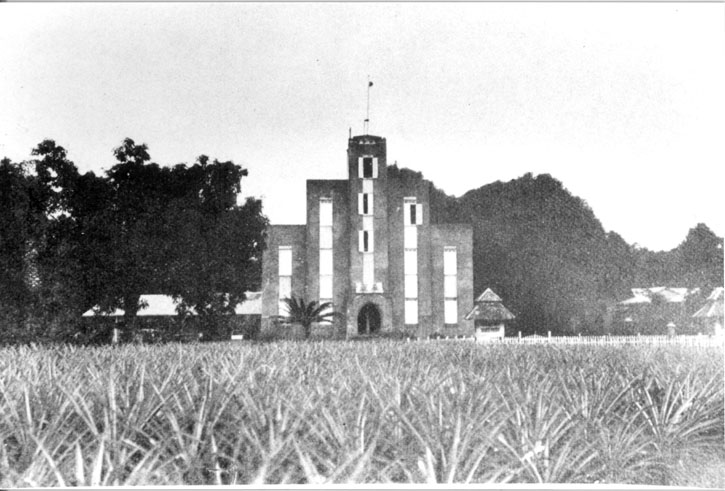
The Pohnpei Botanic garden also has plants with economic importance. A class on a tour from the front of the garden to the back of the garden and thence back to the front would see some of these key gymnosperms and economically important angiosperms. Note that the first gymnosperm is actually outside of the garden.
A walk amongst the gymnosperms and food plants of the Pohnpei Botanic Garden
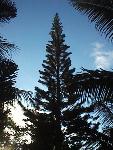
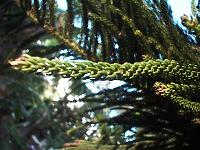

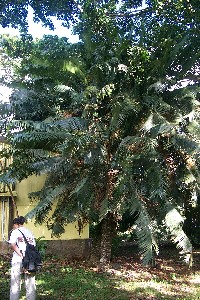
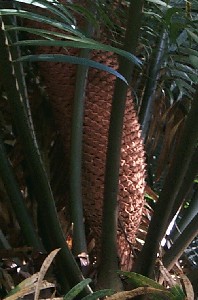
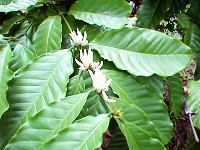
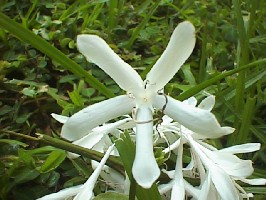
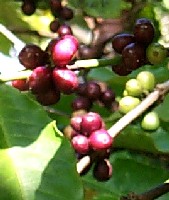

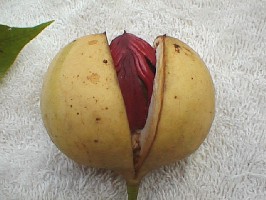
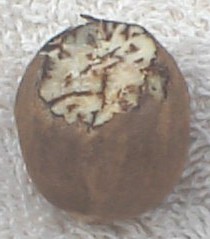
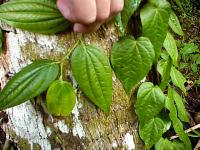
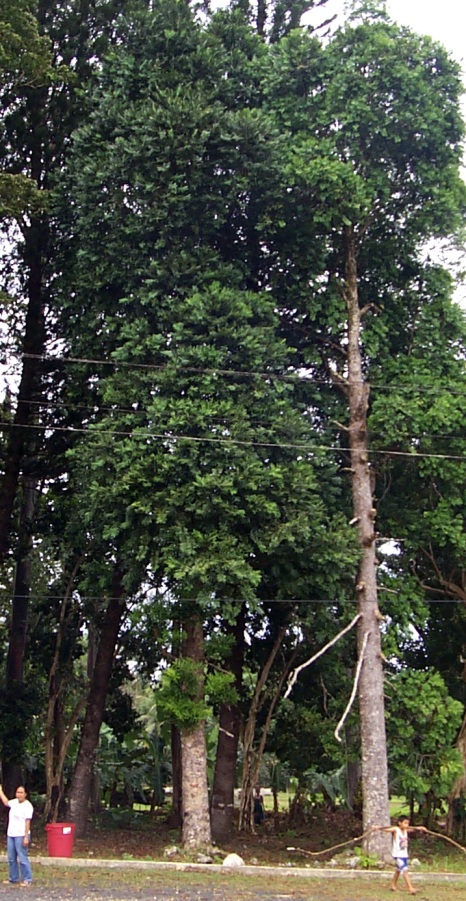
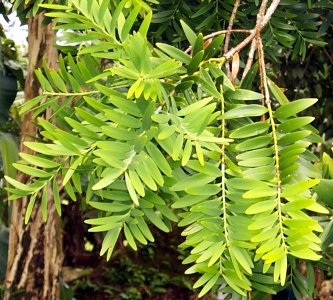
Cycadophyta: All living cycads are slow-growing, long-lived, dioecious (separate male and female plants), thick-skinned, cone-bearing, woody tropical plants that range in size from that of shrubs to that of small trees. The stems have a broad, starch-rich cortex, and may be subterranean (underground) or aerial in different species. Leaf vasculature traces in the stems are girdling (rounded rings around the trunk). Leaves are spirally arranged in crowns on the stem apex (end of the stem), Leaves are pubescent (hairy) when young.
Araucaria morphology
A narrowly conical (shaped like an upside-down pointy ice cream cone) tree to 60 meters tall (200 feet). Trunk clear of branches near the bottom, then the longest branches, with branches being shorter higher and higher on the trunk of the tree. Bark gray, papery, branchlets cord-like, growing in one plane (branchlets are "flat"). Leaves awl-like (little spikes) and triangular in cross-section. Male cone is cylindrical, about seven centimeters long by a little less than a centimeter wide; scales triangular, finely teethed (almost looks like a thick scale). To the untrained eye, at first glance the cones might be mistaken for subbranchlets. Female cone about 12 centimeters long by 12 centimeters wide, somewhat spherical (ball-like), found near top of mature tree. Seeds three centimeters long, nut ovate, wings broadly rounded.
The following flora is roughly in an order in which one could encounter the plants on a walk through the Pohnpei Pwunso botanic garden. This order has been maintained as the status notes often refer to neighboring plants. The flora is the work of David H. Lorence, Diane Ragone, and Timothy Flynn of the National Tropical Botanic Garden, 3530 Papalina Road, Kalaheo HI 96741 USA.
Species, common name, category, status and notes.
Ficus prolixa var. carolinensis, giant banyan, timber. Millenium tree planted 2000 by Pangelinan
Artocarpus altilis. A.mariannensis, Breadfruit, food staple. Most not fruiting. 23 large trees growing mainly on library side of entrance drive. Four on left side of drive near main gate.
Tabebuia pallida, ornamental. Flowers. Inside front entrance gate on left side. Pink flowers.
Moringa oleifera, Horseradish tree. Beside tabebuia.
Syzygium aromaticum, Clove, spice. Tagged as Syzygium caryophyllus: 12 trees planted 4-5 years ago in two rows parallel to entrance drive. Produce in December.
Cassia javanica, pink and white shower tree, ornamental. Few fl, no pods. Tagged as Cassia sp.
Garcinia sp.. Tall, columnar with drooping branches. (430-40 ft. Across from Penny Hotel near fence.
Canarium indicum, nut. Tasty nuts, purple-black with orange pulp, hard shell
Araucaria columnaris, Cook Island Pine, ornamental, Timber. Two rows of five trees with middle row of two trees.
Atuna racemosa subsp racemosa, fruit. One, possibly two trees, growing at end of clove trees, along near edge of parking area where it curves off from entrance drive.
Cassia fistula, Golden shower, ornamental. Flower, tagged as Cassia sp.:Large tree at end of parking area
Roystonia elata [R. regia?], Florida Royal Palm, ornamental. Fl/fruit tagged as Roystonia sp.Along both sides of entrance drive and solitary tree by x side of walkway to office.
Ptychosperma sp. probably P. lineare, ornamental. Flower/fruit Small, 4-stemmed. plant (native species is solitary) by right-hand post of walkway gate. Transplanted from original clump by weather station. There are two large clumps at both ends of front of weather station, reach to roofline.
Latania lodiggesii, Blue Latan, ornamental. Inside office compound on right side of walkway. Another large one on left side of entrance road at the end of the royal palms.
Phoenix roebelenii, Dwarf Pygmy Date Palm, ornamental. Fl/fruit Interspersed with Royal Palms along right side of entrance drive.
Areca catechu, Betel Palm, Ethnobotanical. Fl/imm. Fruit. Tall, spindly palms interspersed with Royal Palms on both sides of entrance drive. Possibly from Yap.
Ravenala madagascarensis, Traveller's Tree, ornamental. Flowers Two large clumps on right side of entrance drive, near weather station.
Dypsis lutescens, Areca Bamboo Palm, ornamental. Fl/fruit. Small clump on right side of entrance drive near weather station.
Latania lodiggesii (female), Blue Latan Palm, ornamental. Very tall fan palm at 15 m, left side of entrance drive opposite the areca.
Arenga engleri, ornamental. Tagged as Unidentified: Very dark green leaves, low clumping. Black, fibrous leaf sheaths. Left side of entrance drive near blue latan and fence.
Samanea saman, Monkeypod Rain Tree, shade. Large tree inside office compound on right side of walkway.
Cordyline fruticosa, Ti, ornamental. Flowers, Growing at base of monkeypod.
Cyrtostachys renda, Sealing Wax Palm, ornamental. Growing by fence inside office compound on left side of walkway.
Averrhoa carambola, Carambola Starfruit, fruit. Fl/fruit. By sealing wax palm, others behind weather station with other fruit trees.
Pterocarpus indicus, Burmese Rosewood, Timber. Pods. Large, old tree with buttress roots growing at rear corner of office building.
Livistona chinensis or related species, Chinese Fan Palm, ornamental. Growing at left rear corner of office building.
Eucalyptus deglupta, Painted Mindanao Gum, Timber. Large tree growing with Livistona and dracaena at left rear corner of building.
Fabaceae unidentified possibly a Senna. Small tree by painted gum.
Cordyline fruticosa (cultivar), ornamental. Growing by painted gum.
Myristica fragrans, Nutmeg Mace, spice. Fl/fruit Planted in the 1970s. Seedlings were to be raised and distributed. Two male trees, two female trees, and two trees with male/ female flowers by fence.
Coffea arabica, Coffee, Beverage. Fl/ fruit Many coffee shrubs planted in spice garden.
Piper nigrum, Pepper, spice. Fl/fruit Vines growing on tree fern supports, building side of coffee/ spice area.
Cinnamomum verum, Cinnamon, spice. 1 with fruits tagged as Cinnamomum zeylanicum: Small tree in coffee/spice area. Two parallel rows along fence under Terminalia trees. [Not C. carolenensis? "madeu"?]
Terminalia kaernbachii, Nut/timber. Fruits. Five tall trees in spice area, growing by side road.
Intsia bijuga, Borneo Teak, Timber. Large tree inside office compound, left side of building before cinnamon. On opposite side of fence from Canarium.
Cycas rumphii, Cycad, ornamental. - Left front corner of office building, near spice area.
Livistona rotundifolia (tentative), Footstool palm, . Growing by cycad.
Bambusa sp., Bamboo, ornamental. Growing inside office compound by Intsia.
Ixora coccinea, Ixora, ornamental. Flowers Grown as hedge in front of weather station. This variety has pale yellow flowers.
Spathodea campanulata, African Tulip Tree, ornamental Pest. Flowers Small tree located near nitrogen-fixing tree nursery. Others scattered around station.
Morinda citrifolia, Indian mulberry, Ethnobotanical. Small tree. Located at corner of nitrogen-fixing tree nursery
Acacia auriculiformis, Timber. Pods Large tree growing along road by nursery, ear-shaped, twisty pods.
Pterocarpus indicus, Burmese Rosewood, Timber. Pods Several trees along road by nursery.
Cassia fistula, Gold shower tree, ornamental. Flower One located beside citrus tree with fig, other nearby has 4 trunks.
Aegle marmelos, Bael tree, fruit. Fl/ fruit Located at mauka end of garage past the nursery. Large trunk with strangler fig overtaking the tree. Small fruit. Fragrant flowers.
Dillenia indica, Elephant apple, ornamental. Fruit Large trunk. Located mauka of citrus.
Lagerstroemia speciosa, Giant crepe myrtle, ornamental. Fruit Large tree, purple flowers. In row between aegle and blighia.
Blighia sapida, Akee, fruit. Fruit Small tree with numerous fruits, in row along building, next to eggfruit.
Manilkara zapota, Sapodillachicle, fruit. Imm. fruit tagged as Achras zapota: Small tree in row between cassia and eggfruit.
Pouteria campechiana, Eggfruit, fruit. In row along building between akee and paperbark.
Melaleucca quiquenervia, Paperbark Cajeput, ornamental. Fl/fruit In row along building between eggfruit and santol.
Diospyros digyna, Black sapote, fruit. Imm. Fruit Two trees. Both in row ending with santol
Sandoricum koetjape, Santol, fruit. Fruit In row beside black sapote.
Averrhoa carambola, Starfruit. Fl/fruit Small tree, laden with flowers and fruits. In row along building.
Artocarpus heterophyllus, Jackfruit. Juvenile. Small tree, located by concrete tank and quarantine office.
Garcinia mangostana, Mangosteen, fruit. Fl, Fruits Approximately 20 trees growing in field townward of quarantine office. Mature, with abundant fruits. Two trees overgrown by strangler figs.
Pouteria campechiana, Eggfruit. Small tree growing in field past farm garden along road bordering compost shed.
Eugenia uniflora, Suriname cherry. Fruit In row by eggfruit. Another tree is growing at far edge of field past acerola.
Terminalia kaernbachii, Timber. Two large trees along road at end of fruit tree planting. Same species as in spice area.
Nephelium lappaceum, Rambutan, fruit. Many imm. fruit Single tree in fruit tree field past farm garden. Six large, mature trees are located on far side of ditch past star apple. Two have fallen.
Garcinia xanthochymus, False mangosteen, fruit. Imm. fruit Large tree. Located in row beside rambutan.
Lansium domesticum, Langsat, fruit. Six trees in middle of fruit tree section. Two horizontal rows of three trees.
Averrhoa carambola, Starfruit. Fl/ fruit Growing in first row of langsat.
Averrhoa bilimbi, Cucumber tree bilimbi, fruit. Fl., fr. Large tree with black bark, twisted branches. Growing by ditch beside starfruit.
Malpighia glabra, Acerola/ Barbados cherry, fruit. Fl., fr. tagged as Malpighia punicifolia: Two trees one small tree with a large trunk. Growing in back rows beside langsat. Vitamin C.
Psidium guajava, Guava, fruit. Four trees.
Diospyros blancoi [tentative id] (velvet apple, a type of persimmon) less probably Flacourtia jangomas [larger tree 5 m x 30 cm, large crenate lvs]. Fruit. Fallen trunk, large leaves, small red, very tart fruit. Growing along edge of fruit field past guavas. This one is nearest the ditch.
Flacourtia sp.2 possbly F. indica. Fruit Growing along edge of fruit field past guavas.
Chrysophyllum cainito, Star Apple, fruit. Very large tree, undersides of leaves are rust-colored. Round, smooth, purple fruit. Growing on far side of ditch.
Pachira aquatica, Malabar chestnut, Nut, ornamental. Two green-barked small trees. Growing along ditch past the star apple.
Agathis lanceolata, Koghis kauri, Timber. Across from tennis court.
Tectona grandis, Teak, Timber. Across from tennis court along back fence
Calophyllum inophyllum, tamanu tree, isou, ituc, sefang, timber, products. Across from tennis court, in corner near the road.
Pimenta dioica, Allspice.West Indian Bay Leaf, spice. Across from tennis court.
Swietenia mahagoni, Mahogany, Timber. Across from tennis court.
Eucalyptus deglupta, Painted/Mindanao Gum, Timber. Across from tennis court.
Gliricidia sepium. Across from tennis court.
Food is the ancient connection to hearth and home. The smell of breadfruit fresh from a stone uhm may bring memories of father and childhood. Plants were the essential ingredient in the move from hunting and gathering to settled civilizations with excess wealth. Plants feed us, and yet they are so much more than mere sustenance.
Thousands of years ago humans were nomadic – moving from place to place, hunting animals, and gathering wild foods. When the food in one area ran short, humans moved on. Very few, if any, cultures still live purely in hunter-gatherer mode.
At some point tens of thousands of years ago humans began to intentionally plant the food plants that they like to eat. Plants take time to grow, so humans had to develop improved shelters that they could build near their crops. Crops also required labor, they represented hard work. Humans began defending their crops and thus their land. The concept of land ownership arose.
A whole new set of skills had to be developed by early humans. Out in the islands anyone can plant a banana tree, but growing large yams takes skill and knowledge. When humans were hunter-gatherers all someone had to know about plants was what was edible and what was not. Even a baby knows how to eat. Intentionally growing plants, especially where they might not naturally grow as on an atoll, requires knowledge. Knowledge passed from father to son, mother to daughter. Education.
Plants as food crops drove the rise of settlements and complex social structures. If there are no villages, as there were not when humans were hunter-gatherers, then there are no village chiefs. Agriculture led to the development of settlements, of villages, and this led to more complex social hierarchies. Organized agriculture meant not everyone had to seek food. There was a food surplus. This allowed some people to specialize in particular activities and skills.
Each part of the planet developed their own crops and foods, and foods became a part of the local traditional cultural systems. Traditions such as presenting first fruits to the chiefs arose. Men in Pohnpei demonstrated their abilities as farmers – their ability to feed and sustain their family – by bringing massive yams to festivals. Those giant yams show everyone that the man who brought it is a provider for his family.
Across Micronesia, both men and women were involved in producing food for the family. Men caught fish from beyond the reef and grew root crops. On Pohnpei men planted yams and climbed breadfruit trees. On Kosrae men planted giant swamp taro and pounded fafa, women produced the el. In Chuuk men harvested and pounded breadfruit. Men were always the providers of the bulk of the food for the family.
Recently western influences have been changing these traditional roles. Although the uhm remains the province of the man across most of Micronesia, the kitchen is more often run by the women in the family. The change in diet from traditional, local foods, to imported foreign foods has also been a shift in gender roles. Women cook the imported rice and fry the imported chicken.
Meanwhile the role of local food diminishes in the daily life of Micronesian. Fermented breadfruit, once a staple, is now prepared only for special occasions.
The shift in diet and life style has also seen a rise in diseases that are firmly connected with diet and a lack of exercise: diabetes and obesity. Traditional food raising required a lot of work – exercise.
In the 1930's a young man in Malem, Kosrae, was on his way to his farm before the sun rose over the Pacific to the East. He worked until near dark, often with nothing more than water or a coconut to drink. He then walked home, heavily laden with bananas, breadfruit, and taro. At home he'd eat heartily and then go to bed to repeat the cycle the next day. Back then bananas hung in the dozens from every cook house, and the call, "Fuhra mungo" could be heard with each house one passed. Hard work all day, big meals of local foods.
Today a young Micronesian may spend the day in an air conditioned office doing no physical exercise. He or she will likely eat two or three meals a day, often of imported foods. Rice is a daily staple. Rice is a fairly simple starch that rapidly breaks down to sugars in the human body. The result has been an epidemic of obesity and associated life style diseases such as diabetes, heart disease, hypertension (high blood pressure), kidney disease, and obesity-related cancers.
Beyond the change in the level of physical exertion, the shift to rice has also been implicated in these life style diseases. Yams, taro, and breadfruit are fairly complex carbohydrates that break down to sugar more slowly in the human body. The speed with which rice converts to sugar causes a rapid rise in blood sugar levels. The speed of the rise in blood sugar is suspected as contributing to diabetes.
Ethnobotany as a field of study can make important contributions to food sources for our increasingly overcrowded planet. "Of an estimated 75,000 edible plants, for example, only 2500 have ever been eaten with regularity, a mere 150 have entered world commerce, and a scant 20, mostly domesticated grasses, stand between human society and starvation." (Richard E. Schultes as quoted by E.W. Davis in Ethnobotany: Evolution of Discipline, Richard Evans Schultes and Siri Von Reiss, 1995, p47.)
Food Plants of Nan'yo: Micronesia in the Time of Japan
Excerpted from Nan'yo: The rise and fall of the Japanese in Micronesia 1885 – 1945 by Mark R. Peattie. Pacific Islands Monograph Series no. 4. University of Hawaii Press, Honolulu, 1988. Additional notes from Rip tide in the South Seas, Willard Price, London, United Kingdom : W. Heinemann Ltd., 1937. All rights remain reserved to the original publishers.
Agriculture: The Fruits of Research
...by the 1930s the finest research work was being done at the Ponape station, largely through the efforts of one man, the distinguished agronomist Hoshino Shutaro, who came to the island in 1927 and set about making Ponape the center of Japanese agricultural research in Micronesia. A tireless researcher who traveled widely, Hoshino scoured the world's tropics for plants, including medicinal varieties, judged to he potentially useful in Micronesia. Through his efforts the Ponape experiment station became one of the foremost world centers for the study of tropical agriculture. There the visiting American journalist Willard Price found him in the mid-1930s, "bluff, hearty, and rubber booted," presiding over a small agricultural kingdom on which he grew cloves and nutmeg from the Celebes, rubber trees from Malaya, vanilla, pepper, and cinnamon from Java, cashew nuts from India, and a multitude of other thriving ground plants, as well as grasses, shrubs, and trees, many of which were the product of his skillful crossbreeding.
From Riptide by Willard Price, 1937: Ponape station had 238 varieties of fruits, vegetables, grasses, shrubs, and trees. Corn from Kansas, chestnuts from Polynesia, cashew nuts from India, cloves and nutmeg from Celebes, alligator pears from Hawaii, lichee nuts from China, Brazil nuts from Brazil, oranges from California, jack fruit from Malaya, mangosteen from Borneo, aloe vera and pomegranate were also brought in. From Java came sapodilla plums, vanilla, pepper, and cinnamon. Mahogany, teak [both still found in Madolehnihmw], sago palm, African oil palm, tamarind [in town near state police station], caiput. Hoshino had also cross-bred ("Burbanked") Japanese rice with a hardier tropical rice from India. Japanese rice could not handle the high amounts of rainfall and needed a dry season. Rice from India was not preferred by the Japanese. The crossbreed had the qualities of both, grew without a dry season, and satisfied the Japanese palate.

By the mid-1930s, moreover, Kolonia was not the only population center on Ponape. On the northwest coast, the government tried its hand at colonization when, in 1931, it established a settlement at Palikir, a small valley in the Sokehs district (Figure 16). Conceived as an important experiment in the suitability of Ponape as a place for Japanese settlement, Palikir (written in kanji by the Japanese as Haruki `coming of Spring') was designed to be a self-sufficient counterpart to the government settlements on Babelthuap. [Palikir is a Pohnpeian word which means "to carry a baby on one's back." The Japanese name of Haruki means "Coming of Spring" so there is no relationship between the Pohnpeian name and the Japanese name.] Certainly its early years appear to have been no less difficult for its founding settlers, twenty-four farm families from Hokkaido who struggled to make a living by growing vegetables to sell to the townspeople in Kolonia, some five or six miles distant.
As the road between Palikir and Kolonia was poor, no vehicles could get to the village, and the first settlers, rising while it was still dark, had to make the trip on foot, carrying their produce on their backs. At first, there was often not enough to eat in the village, let alone to sell. There being no doctor in the community, some who became ill died without medical attention. The rain, heat, and humidity must have tested the strength and endurance of even the hardiest sons and daughters of Hokkaido. Yet somehow, with persistence and dogged effort, the settlers at Palikir put down roots and began to establish a firm economic basis for their community. By mid-decade Palikir was producing an abundance of vegetables that were transported by truck over a substantial government road and sold in Kolonia through the Palikir Agricultural Cooperative.
The villagers soon began to lay out rice paddies as well as vegetable plots; nearby, Nantaku leased land for the cultivation of pineapples; and on the southern edge of the settlement the Wakamoto Company started a cassava plantation. [This location appears to be incorrect. Cassava still grows in a kousapw called "Wakamoto" just south of Pehleng in Kitti. The hills were terraced by the Japanese. William Ioanis and his family now live on that ridge line.] By the time the young anthropologist Umesao Tadao visited Palikir with other members of the 1941 Kyoto South Seas observation mission, its appearance was idyllic. Climbing the ridge that separated Palikir from Kolonia, the visitors were greeted by a woman, clad in the traditional loose trousers of the Japanese farm wife, who escorted them to the settlement. Umesao and his companions felt as if they had come upon a mountain village in Japan, yet the lush mountains, the ferns, and the pandanus palms all spoke of the South Seas:
From the ridge Palikir Village lay spread out before us, a small, isolated world unto itself, in a basin enclosed on the east by a range of mountains and on the west by the lower hills of the Nan Palikir. Here and there patches of fern lay scattered like green velvet from the ridge to the edge of the hamlet. Between them, unexpectedly for the red soil of this volcanic island, were rice paddies. Pineapple fields, laid out in narrow rows, formed plots of a somewhat different shade, and behind the paddies, surrounded by a grove of ivory palms, one could see the roofs of typical Japanese farm houses.
Though the government effort at Palikir, like those in the Palau group, was undoubtedly out of proportion to the returns it received, the eventual success achieved at Palikir appears to have been part of an attempt at the Japanization of Ponape, just as the Marianas had been transformed a decade earlier. With over six thousand immigrants on Ponape by 1941, with Japanese fields and farms rapidly encroaching on the wooded interior of the island, with Japanese villages in the hinterland blossoming into towns, and Kolonia on the verge of transformation from a town to a small city, there is little reason to doubt that had the war not intervened, Ponape would have come to rival Saipan as a Japanese population center.
End of excerpts
In late February 2003 Kazuhide Aruga of Japan visited the College of Micronesia-FSM. He came to visit the Haruki cemetery and pay his respects to the graves of his elder brother and younger sister, Natsue. Although the remains of the adults were exhumed after World War II and returned for reburial in Japan, there were apparently infants buried in unmarked graves. Thus the site remains a cemetery due to the presence of human remains.
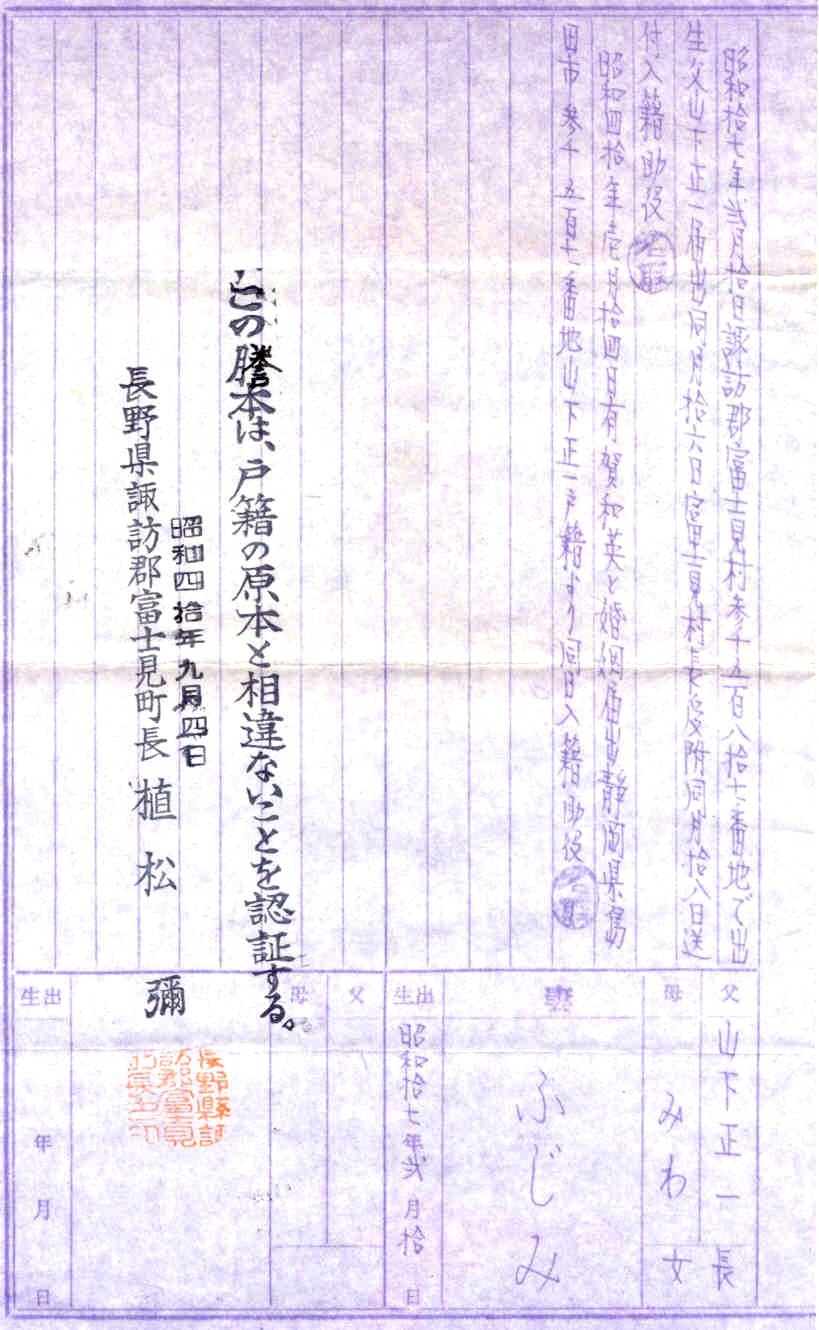
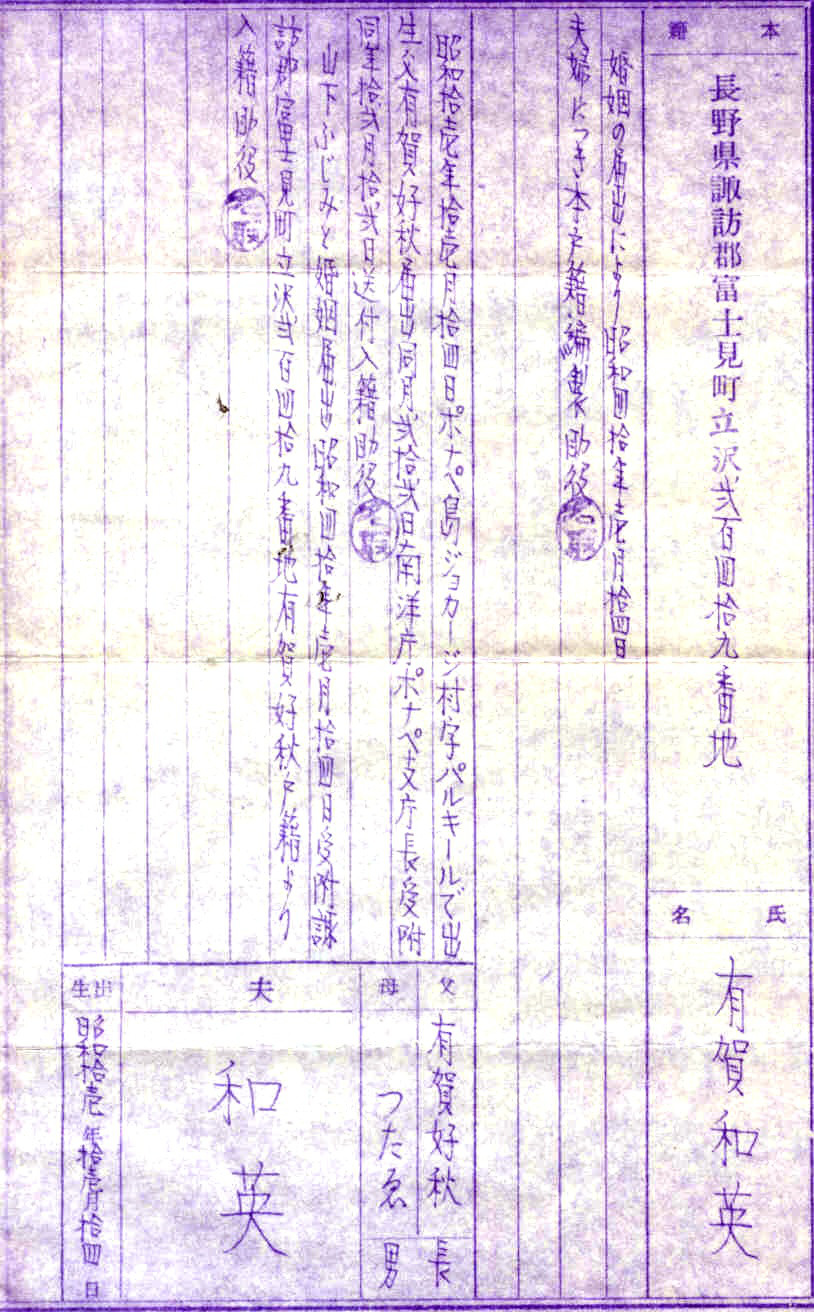
Kazuhide Aruga was born on 11 November 1936 in Palikir, Pohnpei. The elder brother died after a couple weeks of life. This happened before Kazuhide Aruga was born and the elder brother was either unnamed when he died or his name was not known to the younger Kazuhide Aruga. His younger sister was named Natsue. Although Kazuhide Aruga could not remember the exact location of the graves, he seemed to remember the general area as indeed being the location of the original cemetery. At ten years old Kazuhide Aruga had left for Japan after the end of the war with the rest of the Japanese population of Pohnpei.
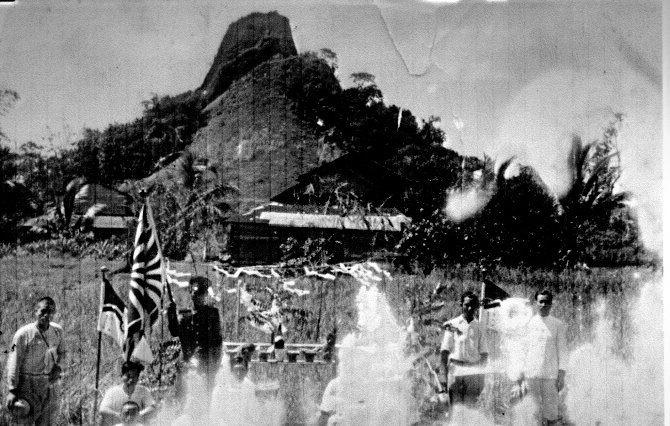
The images on this page include Kazuhide Aruga's birth certificate and an image of Pwisehn Malek taken in 1935. Kazuhide Aruga was not yet born when the photograph was taken.
The stone marker in the cemetery commemorates the death of Hoshino Noritake in 1945. The memorial stone was erected circa 1946 or 1947.
Selected List of Plant Introductions to Pohnpei
Many of the plants found on Pohnpei and in Micronesia were introduced to these islands. Some were introduced by the original Micronesian settlers. These pioneers brought many of their most important plants with them on their voyages. During the 1800's whalers, missionaries, and copra traders brought favored plants and moved plants among these islands. The efforts to introduce plants became increasingly organized and intentional under the Spanish, German, and Japanese administrations. The United States also introduced many plants. Many of these introductions were food plants, but the list also includes spices, fragrances, medicinals, teas, coffee, and material culture plants. During the Japanese administration, as noted above, Hoshino Shutaro single-handedly made what was probably the greatest number of plant introductions.
From the article, History of Introductions to Pohnpei, Micronesia and the Role of the Pohnpei Agriculture Station; Ragone, Lorence, Flynn, Economic Botany 55(2) pp. 290-324. 2001. New York Botanic Garden Press. This list is not comprehensive, please refer to the original article for the complete list. Rights to this tabular material reserved to Economic Botany, New York Botanic Garden press.
Taxon, Common name, Origin, Administration, Use.
Adenanthera pavovnina, kaikes, red sandalwood, unknown, timber.
Adiantum capillus-veneris, maidenhair fern, Java, Japan, ornamental.
Albizia lebbeck, siris tree, German, shade.
Aleurites moluccana, candlenut, Malaya, Japan, oil.
Allium cepa L., onion, German, Japan, United States, food.
Aloe vera, aloe, Tokyo, Japan, medicinal.
Ananas comosus, pweinaper, pineapple, Hawaii, Spain, German, United States, fruit.
Araucaria columnaris, Cook Island Pine, Rabaul, Hawaii, Japan, United States, timber, ornamental.
Areca catechu, pwuh, betelnut, Palau, Japan, stimulant.
Averrhoa carambola, ansu, starfruit, Japan, fruit.
Bertholletia excelsa, Brazil nut, German, nut.
Bixa orellana, annato, Java, German, Japan, dye.
Bombusa sp., pehri, bamboo, early contact, German, Japan, timber.
Bougainvillea glabra, bougainvillea, Rabaul, Japan, ornamental.
Brassica pekinensis, chinese cabbage, Japan, United States, vegetable.
Caesalpinia pulcherrima, sehmwida, pride of Barbados, Spain, ornamental.
Camellia sinensis, tea, Taiwan, Japan, drink.
Capsicum annuum, sele, bell pepper, chili pepper, early contact, Japan, United States, vegetable, spice.
Capsicum frutescens, sele, chili pepper, early contact, United States, spice.
Carica papaya, memiap, papaya, Hawaii, Saipan, Rabaul, Spain, German, Japan, United States, fruit.
Cassia fistula, golden shower, Tokyo, Japan, medicinal.
Casuarina equisitifolia, beefwood, ironwood, Unknown, timber.
Ceiba pentandra, koatun, kapok, German, Japan, fiber.
Cinchona ledgeriana, quinine, Taiwan, Java, Japan, medicinal.
Cinnamomum verum, cinnamon, Java, Japan, spice.
Citrullus lanatus, soika, watermelon, Spain, Japan, United States, fruit.
Citrus aurantiifolia, karer, lime, unknown, fruit.
Citrus limon, lemon, German, fruit.
Citrus sinensis, orens, orange, Philippines, Borneo, Hong Kong, German, Japan, fruit.
Citrus sinensis (L.) Osbeck cultivar Kusaie, orens, Kusaie orange, Kusaie [sic], unknown, fruit.
Clerodendrum paniculatum, pagoda flower, Fiji, Japan, ornamental.
Cocos nucifera L. cultivar King, nih, coconut cultivar, Celebes, Japan, food, drink.
Coffea arabica, koahpi, Arabica coffee, Spain, German, drink.
Coffea canephora (C. robusta), robust coffee, Java, Japan, drink.
Coffea liberica, Liberian coffee, German, drink.
Colocasia esculenta, taro, Hawaii, United States, food.
Cordyline fruticosa, dihng, Tokyo, Japan, boundary marker, skirt.
Cucubita maxima, squash, Japan, United States, vegetable.
Cucumis sativus, cucumber, German, Japan, United States, vegetable.
Curcuma longa, kisiniohng, turmeric, Tokyo, pre-contact, Japan, medicine, dye.
Cycas rumphii, sago palm, pre-Japan, ornamental.
Cycas revoluta, cycad, Ryukyu, Japan, ornamental.
Cymbogon citratus, lemon grass, pre-Japan, fragrance.
Derris elliptica, peinuhp, derris root, pre-Japan, fish toxin.
Dioscorea alata, kehp, yam, early contact, Spain, Germany, Japan, food.
Eichhornia crassipes, water hyacinth, Ponape [sic], pre-Japan, ornamental.
Erythroxylum coca, coca, Taiwan, Japan, medicinal.
Eucalyptus deglupta, painted Mindanao gum tree, unknown, timber.
Eugenia javanica, wax apple, unknown, fruit.
Eugenia uniflora, Surinam cherry, unknown, fruit.
Ficus elastica, Indian rubber tree, Ponape [sic], German, latex.
Garcinia mangostana, mangosteen, Celebes, Singapore, German, Japan, fruit.
Gardenia jasminoides, iohsep, sarawi, gardenia, pre-Japan, fragrance.
Gossypium brasiliensis, cotton, German, Japan, fiber.
Inocarpus fagifer, mworopw, Tahitian chestnut, Polynesia, Japan, nut.
Intsia bijuga, ifil, Borneo teak, native, timber.
Ipomoea batatas, pedehde, sweet potato, Kusaie [sic], Spain, German, Japan, United States, food.
Jasminum sambac, Arabian jasmine, Palau, pre-Japan, fragrance.
Lantana camara, randana, Lantana, Saipan (Nanpei?), German, Japan, ornamental.
Leucaena leucophala, lead tree, tangantangan, Java, Japan, green manure.
Litchi chinensis, litchi, Taiwan, Hong Kong, China, German, Japan, fruit.
Macadamia integrifolia, macadamia nut, Hawaii, Japan, United States, nut.
Manihot esculenta, dapioka, cassava, early contact, German, Japan, United States, food.
Mimosa pudica, sensitive plant, German, invasive.
Musa textilis, manila hemp, abaca, Spain, German, fiber.
Musa x paradisiaca, uht, banana, Taiwan, Marianas, Guam, Marshalls, Philippines, Palau, Anguar, Brazil, Hawaii, German, Japan, fruit.
Myristica fragrans, nutmeg, mace, Celebes, Japan, spice.
Nepholepis cordifolia, rehdil, fern, Fiji, Japan, ornamental.
Nicotiana tabacum, tipaker, tobacco, Saipan, Manila, early contact, German, Japan, stimulant.
Ocimum tenuiflorum, Holy or Thai basil, unknown, medicinal.
Oryza sativa, rice, India, Java, Ryukyus, Taiwan, German, Japan, food.
Passiflora edulis, passion fruit, United States, fruit.
Pennisetum purpureum, pukso, napier grass, Japan, United States, paper, forage.
Persea americana, apokado, avocado, Hawaii, German, Japan, United States, fruit.
Phalaenopsis aphrodite, orchid, Java, Japan, ornamental.
Piper betle L., kapwohi, betel leaf, Palau, Japan, stimulant.
Piper nigrum, black pepper, Java, Hawaii, Fiji, German, Japan, United States, spice.
Platycladus orientalis (Thuja orientalis), oriental thuja, Japan, Japan, ornamental.
Prunus armeniaca, apricot, California, German, fruit.
Prunus persica, peach, California, German, fruit.
Pyschotria ipecacuanha, ipecac, Malaya, Japan, medicinal.
Ravenalla madagacarensis, traveller's tree, peacock palm, Taiwan, Japan, ornamental.
Saccharum officinarum, sehu, sugar cane, Saipan, Palau, early contact, German, Japan, food.
Santalum album, white sandalwood, Tokyo, Japan, medicinal.
Senna alata, candle or ringworm bush, pre-Japan, medicinal.
Solanum lycopersicum, tomato, Japan, United States, vegetable.
Solanum melongena, eggplant, Japan, United States, vegetable.
Spathodea capanulata P. Beauv., African tulip tree, Rabaul, Japan, ornamental.
Sphagniticola trilobata (L.) Pruski, Singapore daisy, United States, circa 1970, ornamental, invasive.
Styrax benzoin, benzoin, Java, Japan, medicinal.
Swietenia macrophylla, mahokani, mahogany, bay wood, Japan, timber.
Sysygium malaccense, Malay apple, Japan, fruit.
Sysygium samarangense, wax jambu, unknown, fruit.
Tamarindus indica, tamarind, Celebes, German, Japan, fruit.
Tectona grandis, teak, Japan, timber.
Theobroma cacao, kakao, cocoa, or cacao, Samoa, Yap, Palau, Rabaul, Spain, German, Japan, food.
Vanilla planifolia, vanilla, Celebes, Hawaii, Fiji, Java, German, Japan, United States, spice.
Vitis vinifera, grape, California, German, fruit.
Zea mays, corn, maize, Spain, German, Japan, United States, food.
Zingiber officinale, sinwer, ginger, Java, Japan, medicinal.
Crop Gene Bank information on bananas
Wild bananas are native to the tropical and sub-tropical forests of Asia and Oceania. They produce inedible fruits that are full of seeds and, like humans, they are diploid, that is they have two complete sets of chromosomes.
More than 50 species of bananas are believed to exist, but two species, Musa acuminata and Musa balbisiana, are better known for their role in the domestication of most types of bananas (a distinct group of cultivars, Fe'i bananas, developed independently in the Pacific region. Karat is a Fe'i banana.). Overall, there are believed to be approximately 1000 varieties of bananas.
A nomenclature system based on morphological characters was developed to group varieties according to the contribution of their wild ancestors, designated by the letter A for acuminata and B for balbisiana. For example, the AA genome group comprises varieties that have two acuminata genomes, while the AAB genome group is for varieties that have one balbisiana genome and two acuminata genomes. Genome groups are further divided into subgroups, which represent varieties that are closely related to each other, or appear to be related.
The main subgroups of dessert bananas are Sucrier (AA), Ney Poovan (AB), Cavendish (AAA), Gros Michel (AAA), Mysore (AAB), Pome (AAB) and Silk (AAB).
The main subgroups of cooking bananas are East African Highland Bananas (AAA), Plantain (AAB), Maoli-Popoulu (AAB), Bluggoe (ABB), Saba (ABB) and Pisang Awak (ABB).
With a few exceptions, diploid varieties are now rare, having been replaced by the more vigorous and productive triploid varieties.
A farmers meeting in October 2003 jointly convened by the Island Food Community of Pohnpei and Pohnpei State Agriculture listed the following varieties of bananas.
Pohnpeian, Other names, Classification, Flesh color, Other comments
Akadahn, Lakadahn, AAA; Green Red, Yellow, Green peel, different from Akadahn Weitahta.
Akadahn, Akadahn en Hawaii, AAA; Red, Yellow, Fruit have red peel.
Dukuru, ABB; Ney Mannan variant, Cream, Very similar to Inahsio Pehsehs, but fruit is short, there are more fingers and a tightly packed bunch.
Iemwahn, AAB; 2, Yellow, Large finger.
Ihpali, AAB; Laknau-like, Yellow, One or sometimes two hands. Large long fingers.
Ihpalihn Palau, Ihpalihn Palau - may be the same as Mangat en Angaur.
Ihpalihn Seipahn, Ihpalihn Seipahn - may be the same as Mangat en Seipahn.
Inahsio Mweimwei, ABB; Bluggoe, Cream, Peel is spotted compared to other Inahsio.
lnahsio Pehsehs, ABB; Bluggoe, Cream, Peel color is like ashes, light green in color.
lnahsio Poh Rotorot, ABB; Bluggoe, Cream, Dark-colored peel compared to other Inahsio.
Kaimana, Kundihna, ABB; Pisang Awak, White, Produces many suckers.
Karat en lap, AAB; Maia Maoli/Popoulu, Yellow, Bunch is not erect; fingers are large.
Karat Kole, Karat Pwonopwon, Fe'i, Yellow-orange, Round-shaped finger.
Karat Pako, Fe' i, Yellow-orange, Large finger; peel is rougher than other Karat.
Karat Pwehu, Fe'i, Yellow-orange, Smaller finger than Karat Pako.
Kudud, Uht Rais, Kirihm, AA; Sucrier, Yellow, Fast cooking. Kudud and Uht Rais may be slight variants.
Macao, AA/AAA; Lakatan?, Yellow, Recently introduced.
Mangat en Alohkapw, AAB; 3, Yellow, Dark-colored skin com-pared to other Mangat.
Mangat en Angaur, AAB; 2, Yellow, Mangat en Angaur may bethe same as Ihpalihn Palau.
Mangat en Kariki, AAB; 3, Yellow.
Mangat en Pohnpei, AAB; 3, Yellow, Many hands compared to other Mangat.
Mangat en Ruk, AAB; 3, Yellow
Mangat en Seipahn, AAB; Plantain, Yellow, Mangat en Seipahn may be the same as lhpalihn Seipan.
Mangat Kingit, AAB; 3, Yellow
Peleu, Utin Koruhr, AAB; Maia Maoli/Popoulu, Yellow.
Preisihl, Brazil, AAB; Pome, Cream, Stem and corm often used for medicinal purposes..\
Sapwtehreng, Mangat family.
Taiwang, AAB; Pisang Kelat, Yellow, Produces many suckers, hardy. Very sweet fruit.
Tikahp, Utinwel, Musa textilis, Wild banana. Formerly used for fiber production.
Uht Mwot, .
Utiak en Angaur, Utiak en Palau, Yellow, Larger plant compared to Utiak en Pohnpei..\
Utiak en Pohnpei, Yellow, Smaller plant compared to Utiak en Anguar.
Utihdol, Fe' i, Orange, Ulin lap family.
Utimwas, Fe'i, Orange, Ulin lap family. Mwas (worm) refers to small fingers.
Utin lap, Fe'i, Orange, Larger finger and darker red peel than Utimwas.
Utin Kerenis, Kirou Rohi, AAB; Pisang Raja, Yellow, Good cooking banana. Kerenis may refer to Kapinga.
Utin Kuam, Uht Laud, AAB; Silk, White, A type of Utin Menihle but finger is larger.
Utin Lihli, Ilario, ABB; Saba, White, Like Utin Ruk but smaller finger.
Utin Menihle, Uht Tikitik, AAB; Silk, White, Finger is smaller than Utin Kuam.
Utin Pihsi, Utin Fiji, AAB; Mysore, Cream, Very sweet and strong aroma when ripe.
Utin Ruk, Poupoulap, ABB; Saba, Cream, Large plant, produces many suckers. Maybe allelopathic towards other bananas.
Utin Wai, Ufin Wai, Mwoatomoat, AAA; Cavendish, White, William's Hybrid
Eight additional cultivars have been newly introduced to Pohnpei from the Secretariat of the Pacific Community, Suva, Fiji lslands: Grande Naine, Yangambi Km5, and the FHIA banana cultivars FHIA-01, FHIA-02, FHIA-03, FHIA-17, FHIA-18 and FHIA-23.
1 The Stover and Simmonds classification by genome and subgroup is used.
2 Maia Maoli/Popoulu-like.
3 The Mangat group of cultivars includes more than one of the Stover and Simmonds sub-groups. The exact sub-group for each cultivar is yet to be determined.
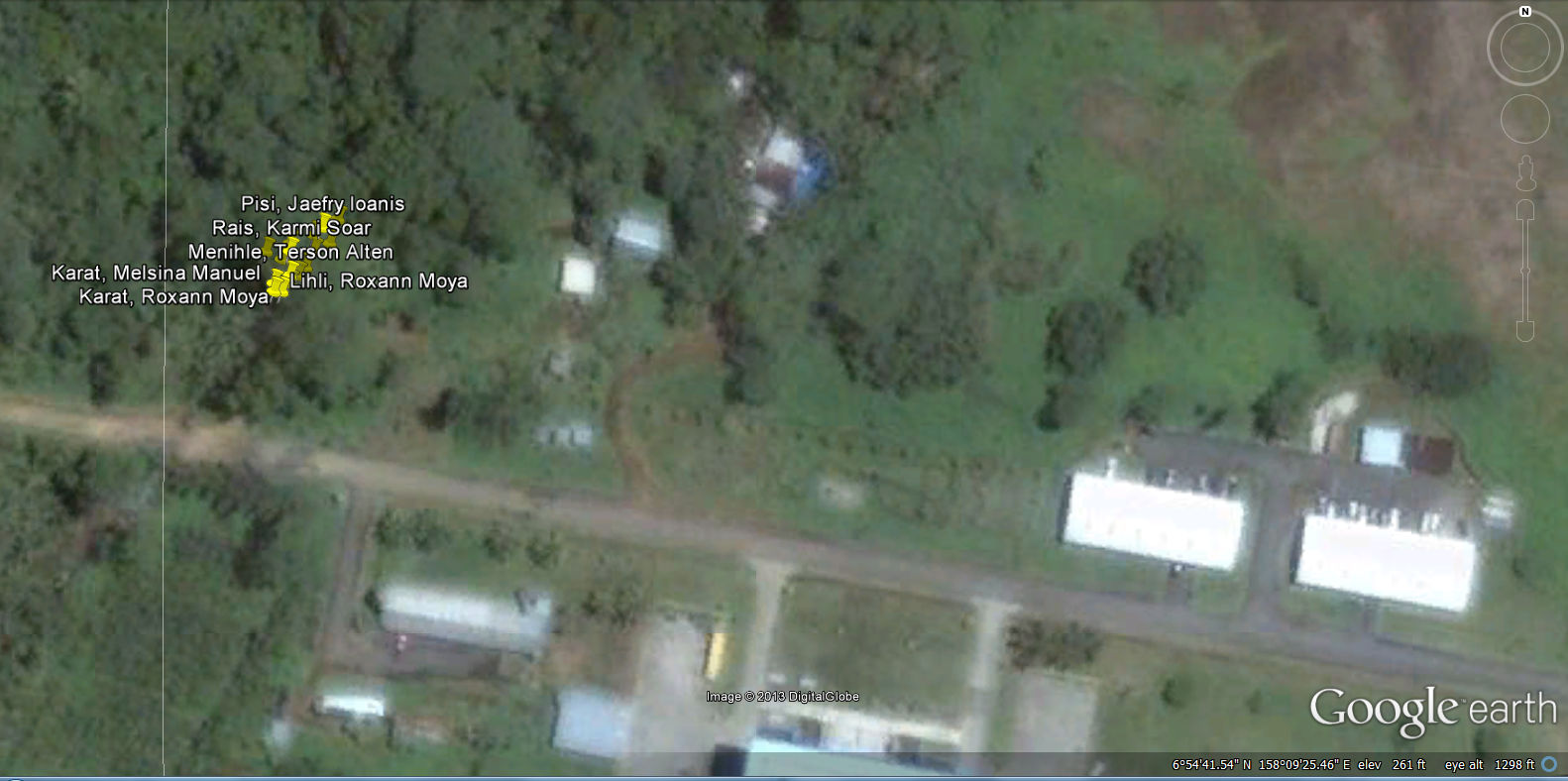
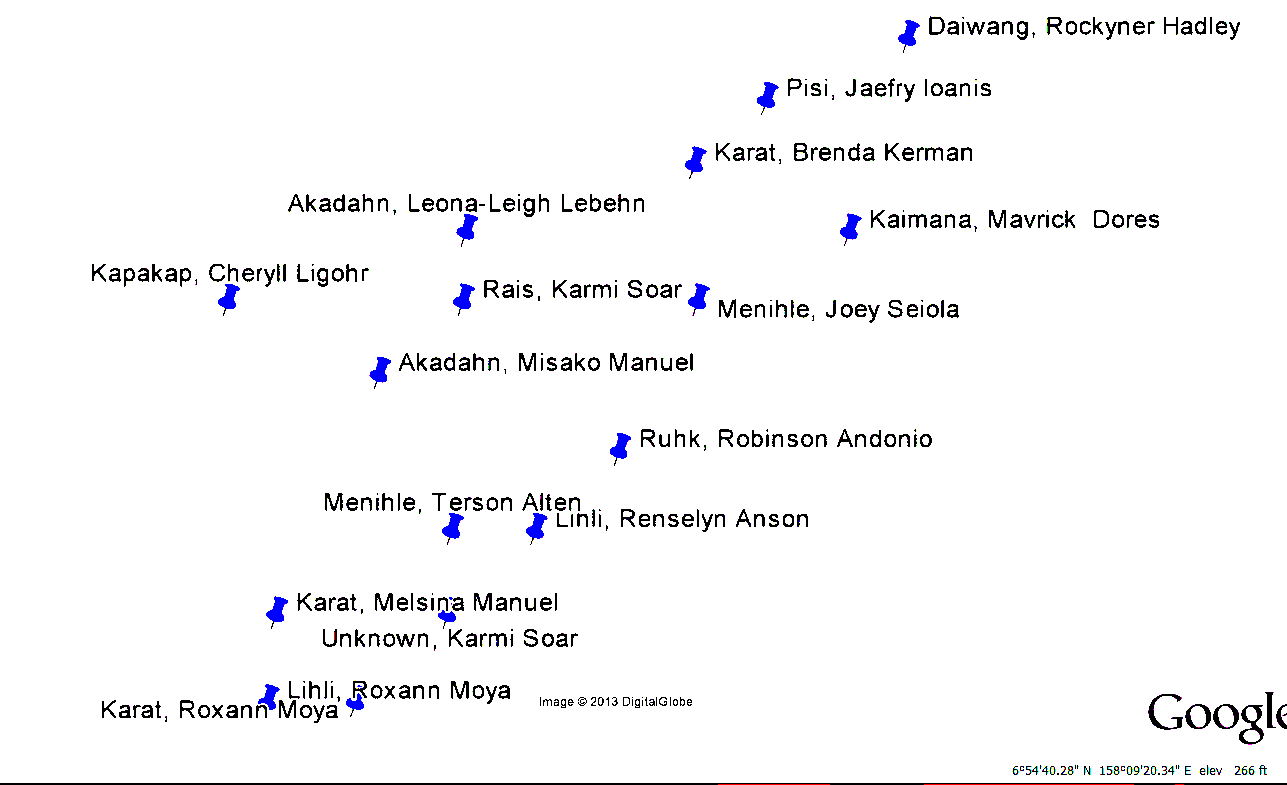
Banana, Latitude, Longitude.
Karat, N 006° 54.627', E 158° 09.330
Karat, N 006° 54.665', E 158° 09.326'
Karat, N 006° 54.666', E 158° 09.325'
Unknown, N 006° 54.666', E 158° 09.327'
Menihle, N 006° 54.667', E 158° 09.327'
Uhten lihli, N 006° 54.667', E 158° 09.328'
Uhten Ruhk, N 006° 54.668', E 158° 09.329'
Karat, N 006° 54.669', E 158° 09.326'
Uhten kapakap, N 006° 54.670', E 158° 09.324'
Uhten rais, N 006° 54.670', E 158° 09.327'
Uhten menihle, N 006° 54.670', E 158° 09.330'
Akadahn, N 006° 54.671', E 158° 09.327'
Kaimana, N 006° 54.671', E 158° 09.332'
Uhten Pisi, N 006° 54.673', E 158° 09.331'
Daiwang, N 006° 54.674', E 158° 09.333'
Brenda Kerman's karat is mislocated in the image.
The final division of plants are the angiosperms. Angiosperms have seeds that are contained inside a fruit. These are considered the most advanced of the plants. Angiosperms are primarily described in terms of their leaf shape, leaf arrangement, flower shape, inforescence arrangment, and their fruit. In this section we examine the shape of the plant and its leaves, as well as the leaf arrangement.
Growth form
Leaf Parts & Arrangement
Venation
Leaf Shapes
Leaf Arrangements
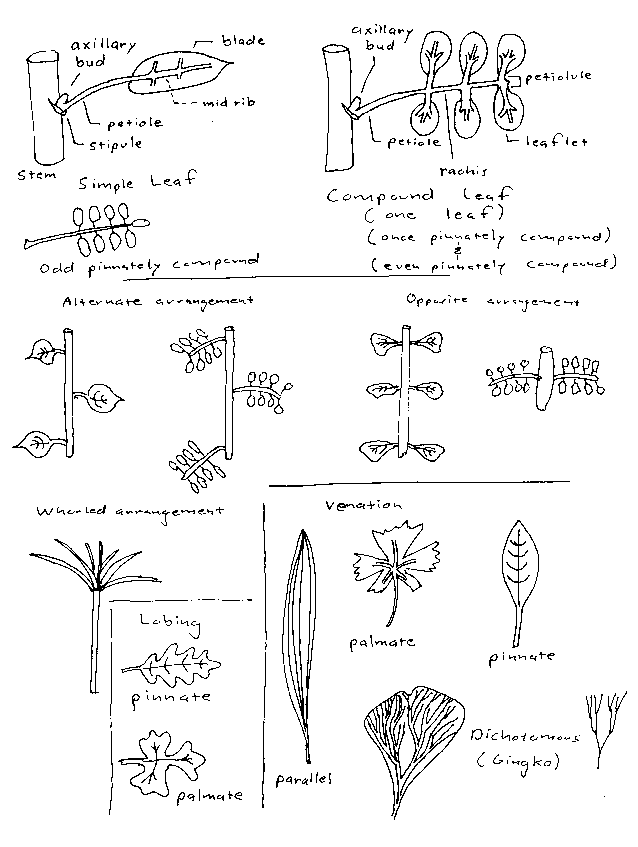
Leaf Shapes
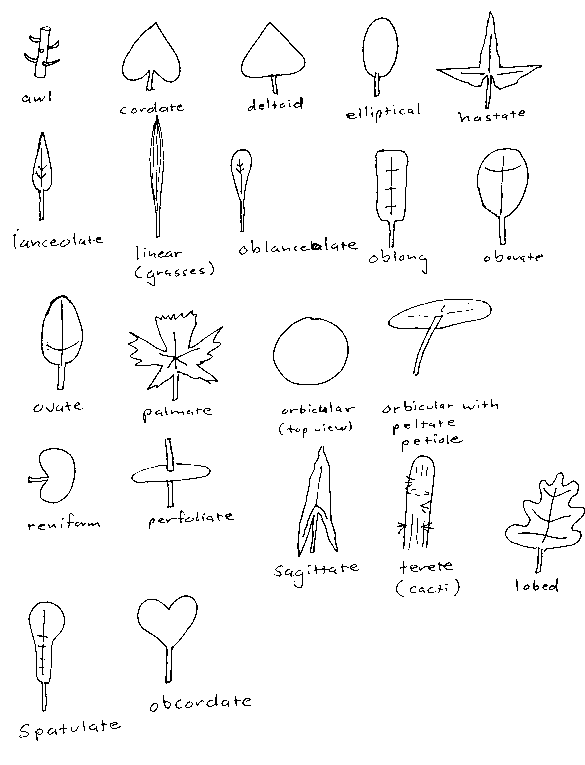
Plants have provided shelter to ancient Micronesians – wood, thatch, and woven walls kept many a family safe from the wind and the rain. Plants provided transportation in the form of outrigger and ocean-going canoes. Plants provided the fibers that were woven and plaited into skirts and other articles of clothing.
Plants provided the materials for containers – containers that hold foods in the form of woven baskets. Other variations of containers led to fish traps and nets.
Plants provided the inks that were used in tattoos. Tattoos were a reflection of Micronesian concepts of beauty, body decor. The area around homes are planted not only with medicinal and food plants, but also with plants that are there only because they are pleasing to the eye. Flower gardens have no known survival benefit, they decorate the yard around the house. In some modern homes the plants have been moved into the house and decorate the interior of the home.
Today coconut oil is being used to produce electrical power and power diesel engines. Plants remain useful in our material lives.
Some plants have many uses. Coconut tree trunks are used as bridges, the fronds are used for baskets. The coconut oil alone has many material cultural uses including the following.
Material culture is the area of the greatest loss of knowledge, the fastest rates of devolution. Micronesians, as a rule, rarely wear traditional clothing, travel to work in canoes, nor live in thatch roof huts. Traditional tattoos with traditional meanings are exceedingly rare. This is the area with the greatest loss of memes – of cultural units of information. Many items of material culture become curios for tourists. Today the Chuukese love stick is sold primarily as a tourist attraction.
The class usually uses the fronds of the nipa palm (Nypa fruticans. Called parem in Pohnpeian). In some terms the class uses the traditional material for Pohnpeian thatching, Metroxylon amicarum, but for larger trees this requires cutting down the tree to access the fronds. Nipa can be obtained non-destructively from the plant.
There are two styles of Pohnpeian thatching, doakoahs en Ruk and doakoahs en Pohnpei or simply doakoahs. Doak means "to pierce" with a needle-like object. Oahs is the Pohnpeian name for Metroxylon amicarum.
On Pohnpei, in the past, the tip of a marlin (a bill fish) was used as a needle. Nowadays the sharpened end of a toothbrush with a hole in the end is a good needle, nails are also sometimes used. Nails with heads, however, do more damage to the frondlet due to their heads. The class often uses needles carved from bamboo.
Expert craftsmanship and skill shows in the even spacing of stitches and the tightness of weave. String is not typically used to stitch the thatch together. Some use the outer skin of the main petiole on oahs. Others unravel rice sacks of woven plastic. On Yap the outer skin of a banana is also used for stitching.
Frondlets are folded so as to create a one-third, two-thirds split in relation to the length of the frondlet. The base is one-third, the apical end is two-thirds. The minor rafters over which the frondlets are folded are made of either Phragmites karka (Chuuk: Woowo, niwo, Kosraen: loa, Pohnpeian: lirau) or Saccharum spontaneum (Kosraen: ac, Pohnpeian: ahlek). The minor rafters are called rahu in Pohnpeian. In the class activity ahlek is often used.
Nipa is too narrow to produce proper doakoahs en Pohnpei. Doakoahs en Pohnpei differs in being laid on a 45 degree diagonal. Note that traditionally Pohnpeian thatch was not covered by a net to protect the roof from wind damage.
On the flat, outer island atolls in mid-ocean the wind is a more significant source of damage. On Pohnpei rain and subsequent thatch rot are apparently more problematic. Pohnpei thatch is not netted down. The thatch is designed to catch the wind and "fluff" slightly, aiding in drying of the thatch and slowing rot.
The nohk is the back half of the midrib. Removing the nohk is necessary when using oahs due to the thick midrib. The oahs frondlet cracks and breaks unless this is done. This is not apparently strictly necessary with parem. The nohk from oahs are then used to make a whisk broom. Teeth are used to crack the midrib and split the nohk. The nohk can also be removed from nipa, but with more difficulty and a smaller resulting nohk.
Kosrae does not have oahs. Kosrae is presently thought to have only four species of palms. Coconut (Cocos nucifera), betel nut (Areca catechu), Ponapea ledermanianna (Kosrae: kitacr, Pohnpei: kedei) , and Nypa fruticans. On Kosrae Nypa fruticans is used for thatch (Kosrae: fahsuc, Pohnpei: parem). Fahsuc is narrower than oahs. Thatching frondlets are laid down in pairs and folded at the midpoint.
In Chuuk pandanus is used for thatch, as well as coconut palm leaf. Coconut palm leaf has a reputation for a short life span across Micronesia.
Linguistic note: dok is "pierce" while oahs refers to Metroxylon amicarum. The combining of the words is what is known in linguistics as verb noun incorporation or incorporated objects. When the word is by itself, it is dok (intransitive), which means to pierce or to stab. The transitive form of it on the other hand is doakoa. The use of /oa/ is sometimes /o/, depending on the following vowel or consonant sounds. For instance, doakoahs, to pierce oahs, dokpwihk, literally to stab a pig (to pig-slaughter), dokomwomw, to spearfish,etc. [Source: Robert Andreas]
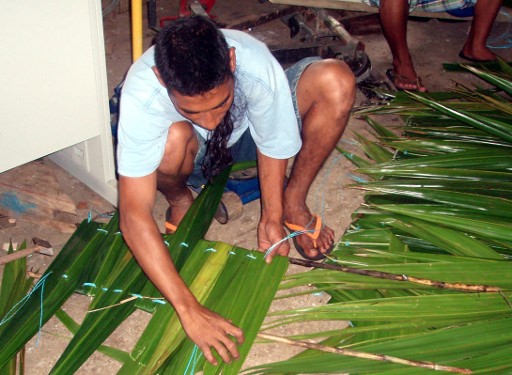
A student works on the thatch unit that goes on the crown of the roof called a pwarapar. [Source: Robert Andreas].
A second way to identify an angiosperm is the shape of the flower and the arrangement of clusters of flowers (an inflorescence).
Parts of a Flower
Pedicel - the stalk of an individual flower.
Whorl: a cyclic group in a flower. The four whorls are the
calyx, the corolla, the androecium, and the gynoecium.
Corolla Shapes
Inflorescence Types
For each, the stalk of the inflorescence is called the peduncle and the stalk of an individual flower is the pedicel.
Flower parts
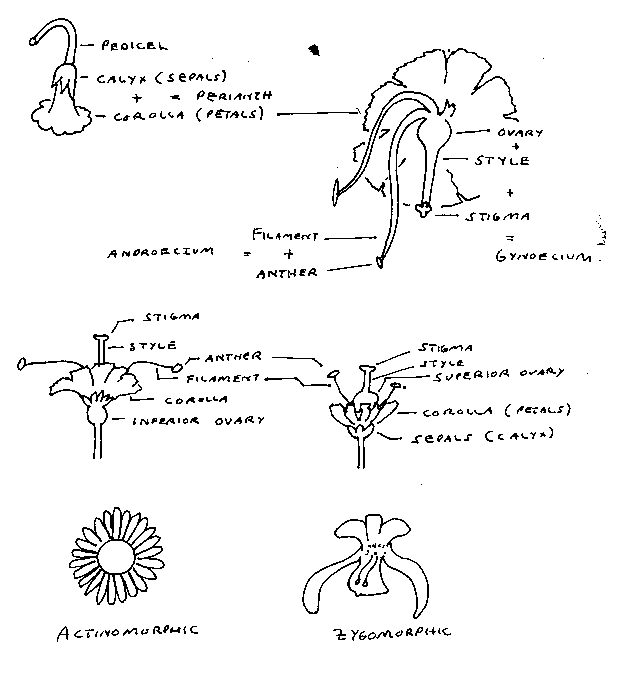
Corolla shapes
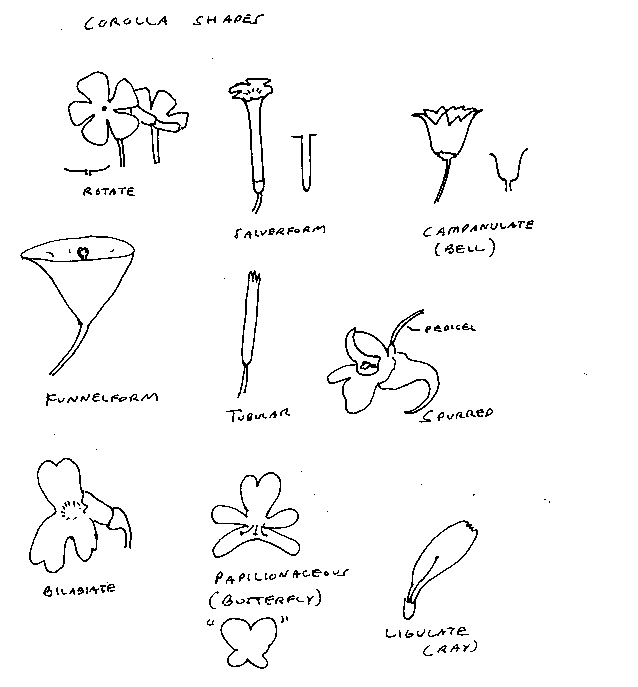
Inflorescence types
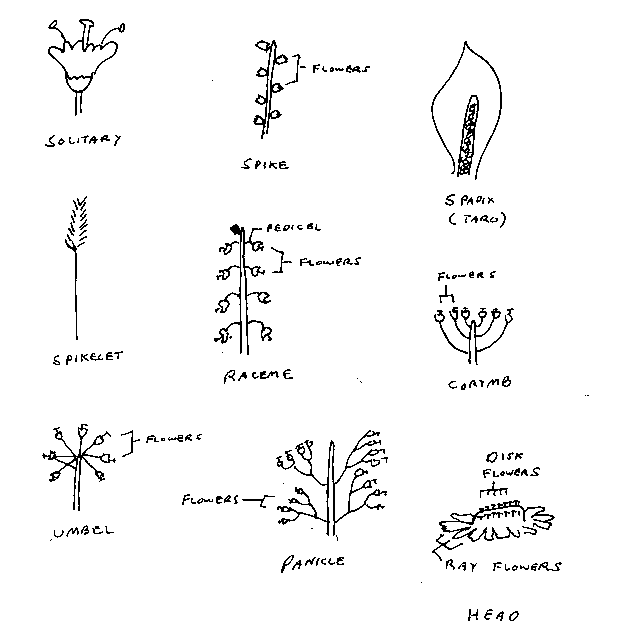
Simplified variant
Angiosperms are characterizable by the shapes of their leaves and flowers. A third identification dimension for angiosperms are their fruit. All angiosperms produce fruit. Fruit is a seed contained within a fruiting body that usually develops from the walls of the ovary of the plant.
Fruit are important to angiosperms. Some fruit, like the outer husk of the coconut, are critical to transporting the fruit. Other fruit are designed to attract an animal. The animal eats the fruit, but typically excretes the seeds. This moves the plant to a new location. Birds and mammals move fruit some of the largest distances.
While starches provide the bulk of the calories in a typical traditional diet, fruit is the attractively sweet dessert in the diet. Fruit is so good that in some cultures fruit is seen as a synonym for that which is desired. Judeo-christian cultures have at the legendary start of the human race the desire to eat a fruit leading to the downfall of humankind.
Fruits include the obvious such as pineapples, oranges, limes, and bananas. Yet any angiosperm seed in its containing fruit is a fruit. Tomatoes are a fruit. So is rice in its original husk. The bright red seeds of the Adenanthera pavonina (kaikes, mwetkwem) when still in their pod are a fruit. The word fruit in botany has a broader definition than in everyday English.
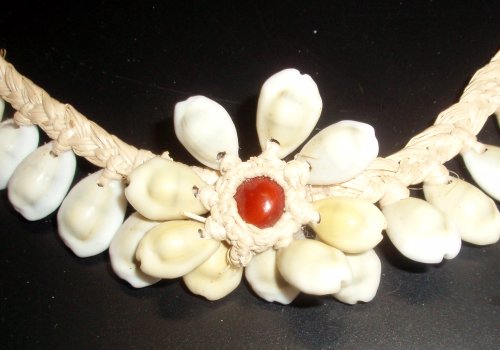
Adenanthera pavonina seed at center of mwarmwar
| Fruit types | ||||
|---|---|---|---|---|
| Simple fruits: single ovary from single flower | Fleshy fruits | Berry: ovary wall soft at maturity | avocado, banana, capsicum (red hot pepper), carambola (star fruit), coffee, grape, guava, kiwi, passion fruit, papaya, tomato | |
| Pepo: ovary wall a hard thick rind | cantelope, cucumber, pumpkin, squash, watermelon. Some include banana and papaya here. | |||
| Hesperidium: leathery rind | orange, lime, lemon, grapefruit, calamansi (calamondin) | |||
| Drupe: hard inner layer | almond, coconut (sometimes also listed as a nut), mango, peach. Some include walnuts and pecans. | |||
| Pome: ovary surrounded by edible tissus | apple, pear | |||
| Dry fruits | Dehiscent: pericarp splits on seams | legume | beans, peas | |
| silique | mustard | |||
| capsule | ||||
| follicle | ||||
| Indehiscent dry: pericarp does not split | achene | sunflower | ||
| anthocarp | ||||
| grain | rice, wheat | |||
| schizocarp | carrot, celery | |||
| samara: small winged fruit | ||||
| nut | acorn, tahitian chestnut, walnut | |||
| Aggregate fruits: many ovaries from single flower | custard apple, raspberries, soursop, sugar apple | |||
| Multiple fruits: many ovaries from many flowers | breadfruit, jackfruit, mulberry, noni, pandanus (also polydrupe), pineapple, strawberry | |||
Plants that entertain, enrapture, inspirit, and bring forth the sacred in us
Forest bathing is not about soap and water. Forest bathing is being in the presence of the forest, being centered in the forest, achieving stillness of the soul amidst the forest. Forest bathing, known as Shinrin-yoku in Japan, has a beneficial impact on the mind, soul, and, by some research, on the immune system of the body as well.
Forest bathing is a different concept from a hike through the forest. In forest bathing, the forest bathing the forest is the destination. Forest bathing is not just a walk in the forest, forest bathing is being one with the forest. Do nothing.
Open your senses. Breathe deep. Relax. Wander. Touch the leaves. Feel the air around you. Take a moment to smell the scents of the forest, the good earth at your feet. Mindfulness is encouraged. Unplug, disconnect, and listen. In silence. The forest will heal you.
Forest batching is not a one off event, a meaningful relationship with the forest occurs over time. A lifetime. Returning reveals the cycles of the seasons, the pulse of the plants, the ebb and flow of greenery. Forest bathing is a practice.
Further reading:
Ancient European druidism considered certain trees and plants to be sacred. Among trees the oak was the most venerated - treated with respect, awe, and worthy of worship. The oak symbolized strength, protection, and longevity. For Celtic druids the word for oak, daur was the same word as the word for God. The wood of the tree held special powers, hence magic wands were made from oak. Acorn, especially those gathered at night, were symbolic of fertility and may have been used in fertility ceremonies.
The druids considered many different trees to be living spirits which could be worshiped or venerated.
In Japan an endemic species of cypress - an evergreen - the sugi tree (Cryptomeria japonica is an integral part of many temples and shrines. The sugi is the national tree of Japan. The oldest temple in Japan is surrounded by a forest of sugi. The tree is perceived to concentrate the mystical forces of nature within the Shinto religious system.
In China the Gingko tree (Gingko biloba) is venerated, often being planted in the central courtyard of Buddhist temples. The two remaining stands of Gingko in the wild may actually have been planted and maintained by Buddhist monks.
Buddhists believe that the Lord Buddha, founder of their faith, was born under an ashoka tree. Thus this tree is also considered sacred and is often found planted in or near Buddhist temples.
In India the Hindu religion also venerates the ashoka tree. The tree is sacred and is dedicated to the god of love, Kama Deva.
For Hindus the banyan (Ficus prolixa) should never be cut as the tree symbolizes life and fertility. Those who are childless worship this tree. Cutting the tree down is believed to lead to a loss of fertility.
The banyan is not only special to the Hindus of India. Kosraeans rarely cut down banyan trees (kohnyah). The tree was believed to be the home of giants and was important in traditional medicines.
On Pohnpei the banyan (aiau) is also known as liketengensapw - that which holds the land together. Pohnpeians rarely cut down this immense tree. Akin to the Kosraeans, the tree is believed to be a mwoalen eni, a home for spirits. The tree is also a source of medicines for both physical and spiritual illnesses.
Chuukese say that if one wants to cut down a banyan (aaw), then one should "kill it well or it may kill you." The inference is that the tree has spiritual powers. Aaw is also used in medicines to protect against evil spirits. Pregnant women are not to go under the aaw as delivery could be difficulty or the fetus could die.
The banana is, in some regions of India, a sacred "tree" that can bring good fortune to a family.
In southern India the Sanskrit name for the coconut palm, Kalpa vriksha, means "the tree that provides all the necessities for life." This echoes the Polynesian wisdom that an atoll is inhabitable by people only if coconut trees grow on the atoll. Weddings and house blessings often include coconut blossoms.
For Hindus the three eyes of the coconut symbolize the three eyes of Shiva, the destroyer of time and ultimately of the universe.
Possibly the most revered plant in Hinduism is tulsi, also known as tulasi (Ocimum tenuiflorum). Tulsi is associated with purity. Yogis wear beads made from the wood of older, larger tulsi shrubs. The beads purify the mind, emotions, and body.
Many Hindu households have a tulsi plant growing in a brick column either in front or in back of their home. Every morning the eldest female in the family lights a lamp, waters the tulsi, and then offers a prayer while walking in a circle around the tulsi plant. Although the tulsi is edible, Hindus will not eat tulsi as the plant is considered sacred.
Tulsi is present at weddings and funerals and is believed to bring blessings upon the household. The plant is a protector of the family.
Elsewhere in southeast asian tulsi is used as a medicinal plant, thus the plant has both spiritual and healing uses.
Even here in on Pohnpei, tulsi planted on either side of a path or driveway will prevent evil spirits from passing. Thus tulsi may be seen as a pair of plants in front of a home. The Pohnpeians call the plant kadiring.
Namoluk also retains a sense of the mystical and magical properties of holy basil (warung, werang) using the plant in "love magic" formulas.
On Yap the plant is known as lamar, on Kosrae the plant is called aring. This plant must have been considered special for it to have been brought to every island long before western contact.
There are five types of psychoactive compounds
Michael Pollan in The Botany of Desire claims that cannabis satisfies a deep human desire for intoxication. Cannabis is a Phantastica drug producer with both healing and psychoactive uses.
Of what use are psychoactive compounds to plants? In sakau the kava lactones may be antifungal. In Cannabis the active compounds, cannabinols, may protect the plant against ultraviolet radiation from the sun.
A subtler use of psychoactive compounds might be to confuse predators: you can't go back to a plant that confused your mind and eat it again. Plants cannot run, so they use a wide variety of chemical defenses to survive.
Memes
Of what use are phantastica compounds to humans? Pollan suggests that they are meme mutagens.
A gene is a physically inherited trait. A mutagen is a compound that can alter genes. Mutations in genes underlie the mechanisms for evolution.
Memes are units of memorable cultural information. Unlike genes they have no biological basis. Memes are a culture's building blocks. Memes are retained or disappear according to how adaptive they prove to a culture.
Memes are passed on to us by our parents, family, friends, people around us: by our environment. Memes are transmitted by cultural education.
The raised eyebrow yes, the concept of a promised land, the sakau apology ceremony, the way we pass items to high titles, the giving up in a race in which you are too far behind are all memes. Learned cultural behavior patterns.
Phantastica drugs may directly alter and mutate memes by altering our mental constructs and the connections in our mind. New ideas, philosophies, concepts, and religions may arise from mutation of memes. New memes are the result of these theorized mutations.
Loss of cultural knowledge, devolution, can be seen as meme loss.
Drugs: For good or for evil?
For over two millenia the peoples of Pohnpei have used sakau as a central part of their custom and culture. The use of sakau did not prevent Pohnpeians from thriving and growing as a civilization. Yet overuse of recreational sakau may be altering and damaging the extended family structure. Some children are effectively "sakau orphans" due to parental "almost every night" sakau habits. Sakau used non-traditionally is damaging to the transmission of cultural memes.
This is true of many plant-based psychoactive compounds. Used in their traditional setting the drug is integral part of the custom and culture. Used in non-traditional ways, especially when over-used or abused, then the compound will damage the culture, the custom, and in some cases the health of the people who abuse the compound.
Areca catechu: Betel nut
Betel nut the drug is actually a combination of three different items:
Areca catechu: the palm which produces the betel nut
Piper betel: the pepper vine that produces the leaf that is chewed with
the nut
lime: a mineral of biological origin (produced from pulverized and baked
coral)
Activity in the human body
Active ingredients
Areca catechu
Arecoline: alkaloid, inhibits Gamma-aminobutyric
acid (GABA) uptake
Guvacoline: alkaloid, inhibits GABA uptake
Piper betel: aromatic phenol compound
lime: increases absorption by increasing salivation,
may alter arecoline and guvacoline into more potent compounds
Positive medical impacts
Arecoline may improve verbal ability, attention, and Visio spatial ability in Alzheimer's disease. - Neuropsychopharmacology 1996 Aug.
Piper betel leaf may contain antioxidants that prevent oxidative damage of Deoxyribonucleic Acid (DNA). Oxidative damage to DNA may be involved with the development of some cancers. - Dept. of Food Health, Taiwan, 2000
Areca catechu may cause milder symptomology in schizophrenia patients and may aid in avoidance of more harmful recreational drugs. - Div. of Cognitive Newscience, New Zealand, February 2000.
Positive personal impacts
Can work harder, longer, with increased clearness.
Negative impacts
Long term use stains teeth, although such stains are considered a mark of wealth in some cultures.
Raises heart rate, blood pressure, body temperature. People with high blood pressure and heart disease are advised not to consume betel nut.
Linked to oral cancer especially when used with tobacco. 88% of oral cancer patients in Taiwan are chewers, 96% of mucous membrane fibrosis patients are chewers of betel nut.
The risk of cancer is increased:
Tobacco is the real problematic addition: it adds carcinogenic nitrosamines (secretariat of the PAC Community)
Much of the information in this section is condensed from Kava - the Pacific elixir : the definitive guide to its ethnobotany, history, and chemistry; Vincent Lebot, Mark Merlin, and Lamont Lindstrom. Rochester, Vermont : Healing Arts Press, 1997.
Kava (Piper methysticum) Family: Piperaceae
Piperaceae 5 genera 2000 species herbs, shrubs, trees, weedy climbers
(lianas)
Leaves usually alternate, entire, petiolate flowers small, grouped on
dense spike.
P. methysticum: Shrub with root stock or stump No rhizome.
Branches distinctly knobby stump knotty, thick, with holes and
cracks.
Fringe roots extend out from stump
No floral reproduction: plants/flowers are sterile. Flowers, but no
viable seed produced. Seed not observed in collected specimens. Most, if
not all, of the plants produce only male flowers. These plants that
sometimes produce female flowers lose them.
P. methysticum is probably derived from P. wichmanii
and may actually be the same species.
Kava has 130 chromosomes: it is decaploid, ten sets of 13 chromosomes
Kava Distribution: Northern Papua New Guinea: multiple names Solomon
Islands, Vanuatu, Fiji Polynesia (Western Yangona: Samoa, Tonga kava
Micronesia, seka, sakau. 118 named varieties, 80 of them in Vanuatu.
Variations are morphological habit: erect, normal, prostrate; stem color;
internode markings; leaf color; pubescences.
Micronesian sakau was introduced either directly from Vanuatu, or via
Baluan in Admiralty islands off north coast of Papua New Guinea (they are
also stone powders of their sakau)
Composition
Six major kavalactones oil soluble (not water soluble) organic compounds containing oxygen.
No one chemical compound generates the effects: all of the major lactones are required.
Compound, Absorption/elimination, Known Effects, Side-effects
Dihydrokavain (DHK): Fast, Sleepiness, muscle relaxant, analgesic, anti-mycotic, Nausea
Dihydromethysticin (DHM): Slow, Sleepiness, muscle relaxant, analgesic, Nausea
Kavain: Fast, Psychoactive, limited antibacterial, mild local anesthetic ("strong" sakau numbs lips due to high kavain).
Methysticin: Slow, Sleepiness, muscle relaxant.
Yangonin
Demethoxy-yangonin
Effects
Potentiation of barbituric narcosis "sleepiness": DHK, DHM. Duration: dependent on DHM, slow to absorb, slow to eliminate. But& super strong Vanuatan"tudei" induces nausea due to DHK and DHM.
Analgesic effects: due to DHK, DHM (pain killing)
Local anesthesia: Due to kava in can paralyze peripheral nerves in high doses (injection)
Anticonvulsive and muscle relaxant . DHM, DHK. affect muscle contractibility directly, not by blocking transmissions from central nervous system. May interfere with ionic mechanisms that control voluntary muscles. Does not affect the involuntary muscles such as heart muscle.
This interference might explain in part damage to peak athletic performance in the days subsequent to a sakau session. Anecdotally this may be as long as four days.
Antimycotic activity: Kavain has limited antibacterial capacity against some forms of gonococcus bacteria DHK is active against the fungus Aspergillus niger.
Absorption: DHK and kavain cross blood brain barrier
Lactones: are organic resins. Not soluble in water. And are contained in
the cells. Hence crushing of the root stock required.
Other effects
Withdrawal
Although kavalactones are not classified as chemically nor physically addictive, there are some transitory effects on the daily kavalactone consumer when he or she stops drinking. Rebound insomnia, sleeplessness or difficulty falling asleep, is the most common withdrawal effect. Insomnia may last from one night to a week. In extreme cases the ability to fall asleep easily may be impacted for up to a month.
Anecdotally, other withdrawal impacts include irritability, headaches, and a general feeling of not being fully oneself and well. In a few people kavalactone consumption causes insomnia. For these rare few, a lack of consumption leads to sleepiness.
Another known after-affect, but not a withdrawal symptom, is intestinal gas. This is due solely to polysaccharides (long chain sugars) contained in the hibiscus sap used in the Pohnpeian sakau service. This gas is due to beneficial microorganisms breaking down the polysaccharides. Although physically uncomfortable, the promotion of beneficial microorganisms crowds out harmful bacteria in the intestines.
Location of the kavalactones in the plant
root stock (center woody portion): 5.28%
lateral roots: 10.44%
-separated in Hawaii processing.
Rahmedel: smooth stems, light color, long internodes
Rahmwanger: darker stems, spots on stem (not smooth), short internodes, Rahmwanger was analyzed.
In descending order of concentration
| Pohnpei | Vanuatu high chief mix |
|---|---|
| DHK | Kavain |
| Kavain | DHK |
| DHM | Methysticin |
| Methysticin | Demethoxy-yangonin |
| Demethoxy-yangonin | Yangonin |
| Yangonin | DHM |
Age of Plant
Kava lactone concentrations peaks after 18 months and remains stable as a percentage of plant content as biomass increases. Sun increases lactone production.
Growing kava
year-round moisture beneficial
prefers dry roots: grows well in mounds or in tree trunks yield strong
varieties. Hates "wet roots" hence hillside preference.
The information herein is provided as is and may not be either wholly or partially correct. All errors belong to the author and his misinterpretations. This document is an ongoing work in progress and at any one time has many errors. Spellings are those of the informants. The author has deliberately chosen not to contradict the spellings offered by his informants. Where two spellings are constitutionally supported, including by municipal constitutions, either spelling or both may appear. This accommodation is necessary as the class may observe the sakau ceremony in either Sokehs or Kitti, depending on the term. In general, the northern phonetic is given followed by the Kitti alternate phonetic in parentheses. Where a word is used repeatedly in a section, sometimes only the lead instance is provided the Kitti alternate.
Thanks for information in the following section are due to Felisihna Spencer Samuel, Robert Andreas, Paul Gallen, Joseph Roby of Paies, Mitsuo Daniel, Francisco Mendiola, Balkario Alexander, Joana Nanpei, and Wilson Kalio among many others. Some of this material derives from the 1978 Preservation of Ponapean Culture[sic] project. The project team consisted of Benjamin Lopez, Linter Hebel, Ihper Dison, Norman David, John Billiman, Domingko Martin, Ioakim David, and Joseph Hallens.
Reasons for the ceremony and cultural importance
The sakau ceremony is truly central to every important activity from birth to death, cradle to grave. Every important point in one's life is celebrated with sakau. Sakau is central to Pohnpeian culture. In some sense one could not be born, one could not marry, and one could not pass away with dignity without sakau in traditional Pohnpeian society.
The method of squeezing the sakau is essentially the same in all ceremonies except the apology ceremony. The apology ceremony squeeze is a special technique, not all squeezers can perform this, maybe only a few. The apology ceremony may also vary in the sequence of events and in the service.
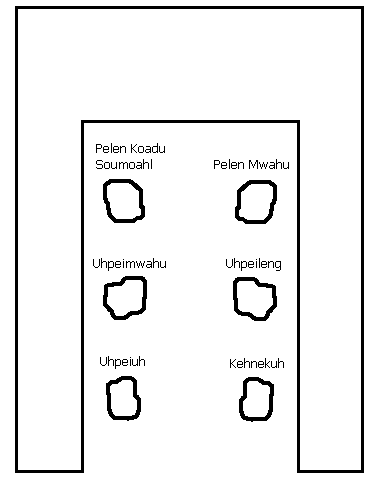 When not in use, no object can be placed on the peitehl (poaitehl), nor can people sit on the peitehl, nor can the peitehl be used as a table.
When not in use, no object can be placed on the peitehl (poaitehl), nor can people sit on the peitehl, nor can the peitehl be used as a table.From research done by Professor Kasiano K. Paul
A. Soangen sakau siluh mie:
Kohre oh kalaidong: sakau rah medel
Kohkore oh Naniepw: sakau rah mwanger
Malahd
Sakau me rahmwanter ah rah medel ahpw pil osada loale.
Sakau pwoatet kin mwadang sansarasang
B. Wiepen sakau laud: sakau Pwalapwal
Sakau laud kin pwalpseseng wianda silpali.
1. Eden pelien sakau kan mie
a. Nahnie
b. Nanpe
c. Rosapal
2. Tepin pwalepen sakau oh edi kan
a. Koasoaiepe de ede kan kohsang ni sakau en pwallap ah tepin pwalpeseng.
C. Wiepen Sakau en Enilahp (Sakau Ro)
Sakau ro kin dokpeseng, ahpw mwowe, mesen rah pahieu kin kohsang mahs.
1. Eden Mesen Rah Kan ni eh rasadahla Pahn Kupwur oh nehnehiong pohn peitehl kan:
2a. Ni ahr kin rasadahla pahn kupwur | 2b. Ni ahr nehnehiong pohn peitehl
a. Limesirihri | Remusleng
b. Limesirahra | Reireinkatau
c. Limesileng | Reiretileng
d. Limesipwel | Reireinkedu
Lakaukod - ahk
a. Kirkikai - Weipwul
1. Weipwul me kin wia lakaukod de ahk, mehn doakoa sakau.
D. Nopwein sakau
1. Kitti (oh Nett) wekisang wehi teikan (sapw ni alem)
a. Pweli - Nahnmwarki
b. Are - Nahnken
c. Esil -
d. Epeng - Nahnwarki (sapw wehi teikan)
e. Alem Soakisoa (sapw Kitti)
f. Dipen koaloau
g. Lopwon
h. Kahp
e. Luh
2. Weng luh wehweki dohte audsapahl
3. Wengpen luh wehwehki augsapahl.
E. Doadaohk me Sakau kin wia
1. Soangen kamadipw koaros
Sakewen tomw: mehn tomw rehn sohpeidi
Sakewen koahmwakele: sakewe pekpwoapwoaud nan tehnpas
Sakewen Pahnta: Sakewen pekpwoapoaud
Sakewen Pwahda: Sakewen peki koasoai
Sakewen enihtik: Sakewen pek wini de repen mour
Sakewen kadawahl: Sakau me wisikdohsang nan ehu wehi ni ei iang kamadipw, de pil ehu soangen diwisou torohr me rasehng pwihk ape.
Title Lines of Kitti
| Oloiso: Nahnmwarki line | ||
|---|---|---|
| Title | Wife (Mwarepein) | |
| 1. | Nahnmwarki | Nahnalek |
| 2. | Wasahi | Nahnnep |
| 3. | Dauk (Nahniau) | Nahntoa |
| 4. | Noahs (Nahnno) | Nahnado |
| 5. | Nahnawa | Nahleio |
| 6. | Nahnpoai | Nahnpwoaipoai |
| 7. | Nahnkiroun Pohndake | Nahlikiroun Pohndake |
| 8. | Nanihd Lapalap | Nanidipei Lapalap |
| 9. | Loampwoai Lapalap | Pwoaipoai Lapalap |
| 10. | Saudel | Koadindel |
| Serihso: Nahnken line | ||
|---|---|---|
| Title | Wife (Mwarepein) | |
| 1. | Nahnken | Nahnkeniei |
| 2. | Nahlaimw | Nahnkulai |
| 3. | Nahnsahuririn | Nahlisahuririn |
| 4. | Nahlik Lapalap | Nahlikiei Lapalap |
| 5. | Nahnapas | Nahnapasepei |
| 6. | Nahnmoadoau en Idehd | Nahnkoadin Idehd |
| 7. | Souwel Lapalap | Eminalau Lapalap |
| 8. | Loapoan Ririn | Lampein in Ririn |
| 9. | Oauririn | Lioauririn |
| 10. | Kaniken Ririn | Kanipein Ririn |
| 11. | Nahnpohn | Koadipohn |
| 12. | Oaunpohn | Liounpohn |
The tables above are based on notes from Felicy Spencer and the 1978 documents cited below. Differences exist between municipalities. Wein Kitti Nahlik Lapalap kohsangoloiso kolahng serihso, nanpwungoan Nahnsahuririn oh Nahnapas #3 oh #4 Serihso. [Preservation of Ponapean Culture seventh grade, 1978, page 2-3 where the note is attached to a table in a non-Kitti order.]
There exists a third line, the line that was once the traditional religious leaders. Although the line still exists, titles are still given, and some roles are retained, the religious aspects have been all but lost as far as this author is aware.
Title line order is not necessarily the same as social rank order. Municipalities (wehi) have other lines other than Nahnmwarki and Nahnken lines. The following tables lists the highest ranking titles in each wehi in their rank order. The Nahnmwarki of each municipality also has their own unique title.
Top titles by wehi, spellings consistent with wehi constitution
Madolenihmw
Nahnmwarki: Isipahu
Nahnken
Lepenmoar
Likend
Nahnkeniei
Kitti
Nahnmwarki: Soaukisoa
Nahnken
Rohsa
Nahnalek
Nahnkeniei
Rohspein
U
Nahnmwarki: Sahngoro
Nahnken
Nahnalek
Wasahi
Sokehs
Nahnmwarki: Soumakahn Pikehn Iap
Nahnken
Lepen Palikir
Nahnalek
Nahnkeniei
Lampein in Palikir
Nett
Nahnmwarki: Pwoud Lepen Nett
Nahnken
Lepen Nett
Nahnalek
1For further information on orthographic issues, refer to Linguists, Literacy, and the Law of Unintended Consequences. The choices made in this document are controversial. The state constitution does not mandate a particular orthography, while the Kitti municipal constitution supports the use of a variant spelling system based on pronounciation. Those who disagree with the variant spelling argue for "one spelling-two pronounciations." Those who defend the variant spelling note that the variant spelling is in keeping with maintaining a phonetic orthography. Ultimately, the designation of the phonetic spelling system of four municipalities left the spelling system of Kitti as "non-standard" and "wrong." In islands where spelling is phonetic, this left open the implication that Kitti dialect is "non-standard" which is offensive to those from Kitti. The result is rather open rebellion against the standard orthography, with many schools in Kitti actively teaching the variant spelling system. As an outsider, this author is unable to take sides. Thus this author gets lectured by those who feel the inclusion of Kitti spellings is wrong, which is exactly why those who support the variant spelling are so stubborn about clinging to the spelling. No one wants to be lectured to about how wrong they are. Where possible, Kitti variants are included in parentheses.
2 The municipality names are orthographically problematic as their official spelling does not conform with either the northern or southern phonetic orthography.
3 The author owes a debt of gratitude to the people Wone, Kitti, for giving the author the opportunity to understand cup movements first hand.
Attenborough, David. The Private Life of Plants. Princeton University Press; 1st edition (August 21, 1995)
Balick, Michael J. and Cox, Paul Alan. Plants, People, and Culture: The Science of Ethnobotany (Scientific American Library). W H Freeman & Co (January 1996).
Sumner, Judith. The Natural History of Medicinal Plants. Timber Press (April 7, 2008).
Whistler, W. Arthur. Samoan Herbal Medicine: O La'au Ma Vai Fofo O Samoa. Isle Botanica (June 1, 1996).
Living plant collections consisting of plants people use, of culturally important plants, are ethnogardens. Ethnogardens provide a place one can go to see and learn about plants and their uses. For the College of Micronesia-FSM Palikir National site the campus is an extended ethnobotanical garden.
Tending to and cleaning in an ethnogarden
First, obtain a guiided tour of the area. Learn which plants are supposed to be there, and which are not. Learn the names and uses of the existing plants. The plants that are supposed to be there are often termed "the collection."
Second, learn the pruning, preening, and cleaning ground rules for the garden. For example, on the College of Micronesia-FSM Palikir campus the threat to the collection are primarily an invasive sun-loving grass (Ichaemum polystachum, reh padil) and an aggressive native vine (Merremia peltata, iohl, puhlah). Thus the following guidelines to cleaning garden: